Int'l Finance 笔记
本文是国际金融管理的笔记,教材是「Eun C. and Resnick B. : International Financial Management, 9th ed」
L0 - Course Overview
L1: Introduction to International Finance & International Monetary System
L2 – 4: concentrate on exchange rates
L5: focuses on foreign currency derivatives
L6 & 7: delves into exchange rate exposure of firms and the steps to mitigate its impact
L8: looks at recent trends in international equity markets and international investments
L9: addresses global cost-of-capital and sourcing equity & debt globally and political risk
L10: discusses international capital budgeting
L1 - Intro & IMS
Costs of Globalisation:
- exchange rate
- large tariffs
- subsidize
Prevalent Exchange Rate System
- Currency Union / Dollarization
- Currency Board
- Truly Fixed ER
- Adjustable Peg
- Crawling Peg
- Basket Peg
- Target Zone or Band
- Managed Float
- Free Float
The Gold Standard (1873-1913)
The Gold Standard
- Countries fixed an official gold price
- free convertibility between domestic money and gold
- e.g. 1 ounce = USD 20.67
- The gold price is "mint parity" (determines exchange rate)
- National currency is only issued with gold backing
For Example:
- USD is pegged to gold at $20.67 per oz
- British pound is pegged to gold at £4.2474 per oz
- Therefore, $20.67 = £ 4.2474 (£1 = $4.8665)
Arbitrage Profits (if £1 = $4)
- Buy gold at £4.2474
- Sell gold at $20.67
- Convert at $4 = £1, Get £5.1675
- Profit = £(5.1675-4.2474) = £0.9201
- Note: Do the reverse and you will incur a loss of $3.68
Bretton-Woods (1944-1973)
Bretton-Woods
- USD was fixed in terms of gold (USD 35 per ounce)
- Other countries fixed their currency relative to the USD
- Allowed to vary between ± 1% of the "par value"
- US did not declare any official parity
- Fed was never under any obligation to intervene
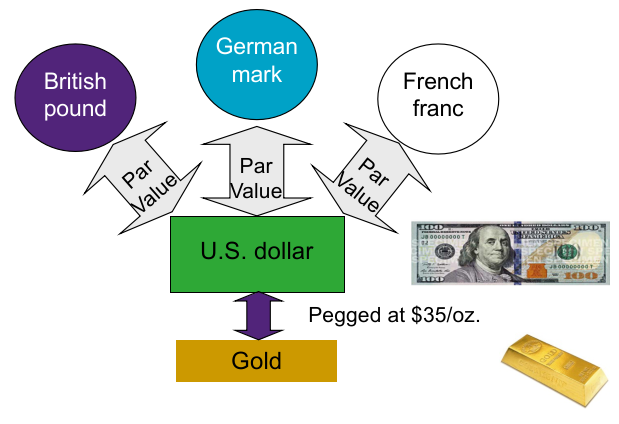
Triffin Paradox: Conflict between economic growth (and hence growing need for reserves) and credibility of covertibility
- Crisis of confidence in the US's ability to meet its obligations
- diverging fiscal, monetary policies and external shocks caused the system's demise
- In 1968 two tier pricing system was created
- August 1971 USD devalued to $42/ounce and the "gold window" was closed
- In 1973, the Bretton-Woods system collapsed
The Floating Rate Standard (1973-1984)
exchange rate is determined entirely by forces of supply and demand
Central banks had the obligation to intervene to prevent "disorderly conditions"

Central Bank's Balance Sheet
to avoid appreciation of AUD
RBA sell AUD and buy USD or foreign assets from financial institutions
it affects the money supply (non-sterilised)
RBA then swap this foreign asset with the government bonds (sterilised)
RBA effectively changes composition of the assets
from foreign asset to domestic asset

Impossible Trinity
Three Goals (must give up on one)
- Exchange Rate stability
- Full Financial Integration (free flow of capital)
- Monetary independence (of domestic policies)
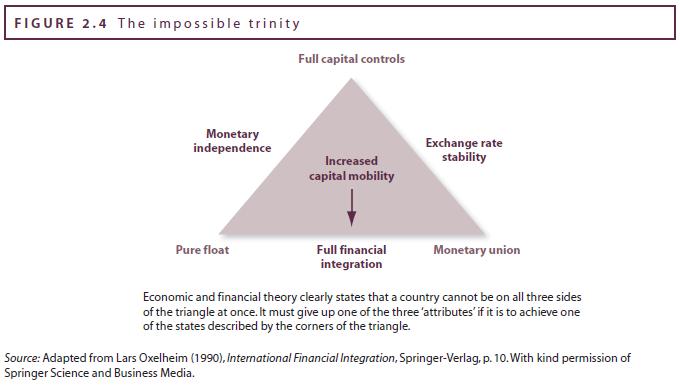
Example Country
- Pure Float: USA
- Monetary Union: EU
- Full Capital Controls: China
L2 - The Foreign Exchange Markets (FOREX)
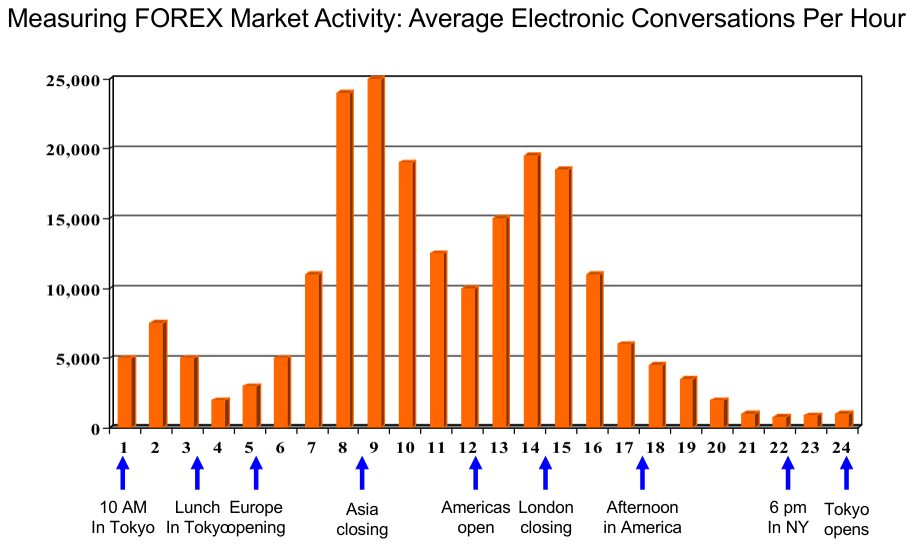
Settlement Risk
Settlement Risk: the possibility that one or more parties will fail to deliver on the terms of a contract at the agreed-upon time
Netting: aggregating two or more obligations to achieve a reduced net obligation
Netting Example:
- CBA owes Citigroup $10 billion
- Citigroup owes CBA $5 billion
- Citigroup owes Construction Bank $5 billion
- Construction Bank owes CBA $5 billion
- Gross payments: $10 + $5 + $5 + $5 = $25 billion
- Netting: $0 transaction value
FX Activities
Hedging: transfer exchange rate risk inherent in foreign currency transactions
Speculation: leaves one open to exchange rate fluctuations (aims to make a profit)
Arbitrage: take advantage of inconsistent prices to make risk free profits (unlikely to last long)
- Spatial (or Locational) Arbitrage
- Triangular Arbitrage
- Covered Interest Arbitrage
FX Rates and Quotations
Spot Rate: The exchange rate at which trades are executed immediately in the interbank market.
Value Date (for a spot transaction): the date on which parties actually receive the funds they have purchased
- usually occurs two business days after the deal is made
Direct Quote: Home currency per unit of Foreign currency (FC)
- AUD/€ quote is 1.6003
Indirect Quote: Foreign currency per unit of Home currency
- €/AUD quote is 0.6249
Note that in all cases, the reciprocal of a direct quote is an indirect quote:
American terms: US$/FC
European terms: FC/US$
Bid - Ask Prices
Bid Price: Dealer BUY FC from you
Ask Price: Dealer SELL FC to you
Ask Price > Bid Price (the difference is the Bid-Ask spread)

Bid = 1.4482 $/£
- Dealer buys £ for $ at the Bid
- Client sells £ for $
- Dealer will buy £1,000,000 sell $1,448,200
Sell = 1.4484 $/£
- Dealer sells £ for $ at the Ask
- Client buys £ for $
- Dealer will sell £1,000,000 buy $1,448,400

A direct bid (ask) is the reciprocal of an indirect ask (bid)
- Bid-ask quote for AUD/€ = 1.6003 – 1.6499
- Bid-ask quote for €/AUD = 0.6061 – 0.6249
Cross Rates
Many currency pairs are only inactively traded, so their exchange rate is determined through their relationship to a widely traded third currency
For Example:
- Australian dollar = A
- Danish kroner = DKr7.0575/US$
- Then A$/Dkr = (A) / (DKr7.0575/US$) = A$0.2186/Dkr
Triangular Arbitrage
- Barclays Bank: A$1.8410/£
- Westpac Bank: A$1.2223/€
- Deutsche Bank: €1.5100/£
- Cross Rate: (A$1.8410/£) / (A$1.2223/€) = €1.5062/£
- Cross Rate < €1.5100/£ (£ Overvalued at Deutsche Bank)
- Strategy: Buy € and Sell £
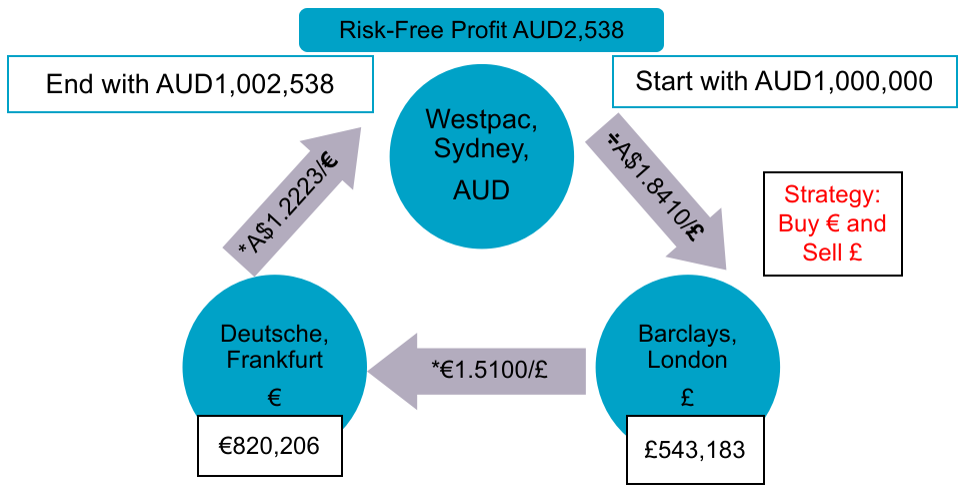
Cross Rates (Bid - Ask Rate)
- AUD: A$1.5455 - A$1.7158/USD
- DKK: DKr7.0680 - DKr8.1280/USD
- Bid = (A$1.5455/USD) / (DKr8.1280/USD) = A$0.1901/DKr
- Ask = (A$1.7158/USD) / (DKr7.0680/USD) = A$0.2428/DKr
Forward Contracts
Forward Contracts: a rate that is agreed upon today, but settled further into the future
Three ways to express forward rates:
- Outright quotes (either direct or indirect)
- Points to be added or subtracted from spot rate
- Annualized percentage forward premium or discount
Outright quotes
Currencies which are more (less) expensive to buy forward are at a premium (discount)
For the denominator currency, Forward > Spot implies a premium of foreign currency forward
- S = 0.9077 $/SF, = 0.9129 $/SF
- The forward Swiss franc is more expensive to buy
- The forward Swiss franc is trading at a premium to the spot Swiss franc (relative to the dollar)
Swap Rates
Swap Rates: the difference between the forward rate and the spot rate
FX traders usually quote forward rates in terms of points
- A point is the last digit of a quotation
- A point is equal to 0.0001 of most currencies
- JPY is quoted only to two decimal places (0.01)
Bid Points > Ask Points: Subtract the points from the spot rate (to get the outright forward quote)
- forward discount
Bid Points < Ask Points: Add the points to the spot rate (to get the outright forward quote)
- forward premium
Example (European Terms, Sfr/$):
- Spot: 1.5625 - 1.5635
- One month forward: 58 - 56
- Three months forward: 175 - 169
- Six months forward: 342 - 334
- F (1 month)
- Bid = 1.5625 - 0.0058 = 1.5567
- Ask = 1.5635 - 0.0056 = 1.5579
- F (3 month)
- Bid = 1.5625 - 0.0175 = 1.5450
- Ask = 1.5635 - 0.0169 = 1.5466
- F (6 month)
- Bid = 1.5625 - 0.0342 = 1.5283
- Ask = 1.5635 - 0.0334 = 1.5301
Annualized Percentage Forward Premium / Discount
- p > 0: annualised premium of the denominator currency
- p < 0: annualised discount of the denominator currency
- N: maturity of the forward contract (or number of days forward)
For exchange rate: USD/AUD
- If F > S then the currency is trading at a premium
- E.g. One AUD buys more USD in the forward market than in the spot market
- If ascending between bid/offer (i.e., 23 -24 one-month swap points) then forward price will be higher than the current spot price
- If F < S then the currency is trading at a discount
- E.g. One AUD buys less USD in the forward market than in the spot market
- If descending between bid/offer (i.e., 58 - 56 one-month swap points) then forward price will be lower than the current spot price
- If F = S then market is relatively flat
For Example:
- Spot = 0.8772 $/€
- = 0.8785 $/€
- = 0.8806 $/€
- = 0.8891 $/€
- Euro is more expensive in the forward market
- The forward Euro is at a premium
Change in the Spot Exchange Rates
- At t-1: A
- At t: A
- Change: (1.335 / 1.8445) - 1 = -27.62%
- the USD has depreciated relative to the A$ by 27.62%
- At t-1: 1 / (A
- At t: 1 / (A
- Change: (0.7491 / 0.5422) - 1 = 38.16%
- the A$ has appreciated relative to the USD by 38.16%
L3 - Parity Conditions
Parity Conditions: exchange rate is a pair of currencies. Our task - Link this pair with another pair (better if observable)
Parity conditions rely on ARBITRAGE to hold: If they are the same thing, they must cost the same
The derivation of these conditions requires the assumption of Perfect Capital Markets (PCM)
- no transaction costs
- no taxes
- complete certainty
Purchasing Power Parity and Low of One Price
Purchasing Power Parity (PPP)
- based on the notion of arbitrage across goods markets
- given by the Law of One Price (LOP)
- Violations of PPP occur in the short run, but PPP tends to hold in the long run (several years)
Law of One Price (LOP) states that the price of an identical good should be the same in all markets (assuming no transactions costs)
Internal purchasing power = external purchasing power
- A can of coke should cost the same in Australia as it does in Thailand
LOP Example
- Coca-cola: Aus = $4.25/bottle, UK = £2.5/bottle
- Spot rate ($/£) = 1.70
- Buy for $4.25, or flies to the UK and buy for $4.25 × (1£ / $1.7) = £2.5
- The "PPP" exchange rate = ($4.25/bottle) / (£2.5/bottle) = $1.7/£1
Big Mac costs SKr61.29 in Sweden and $5.69 in the US, is SKr overvalued or undervalued if the actual exchange rate is Skr10.45/$1?
SKr61.29 × ($1 / Skr10.45) = $5.865 > $5.69
Therefore Skr overvaluation
Absolute PPP
Absolute PPP
- less extreme form of the Law of One Price
- the price of a basket of goods would be the same in each market
Relative Purchasing Power Parity (Relative PPP)
Relative PPP claims that exchange rate movements should exactly offset any inflation differential between two countries
(Minus 1 from both sides)
Relative PPP implies that the change in the exchange rate will offset the difference between the relative inflation of two countries.
Therefore the above can be approximated as:
- : %change in exchange rates
- : %change in A's levels
- : %change in B's levels
Applications of Relative PPP:
- Forecasting future spot exchange rates
- Calculating appreciation in "real" exchange rates
Relative PPP Example
Given inflation rates of 5% and 10% in Australia and the UK respectively, what is the prediction of PPP with regards to $A/GBP exchange rate?
(0.05 - 0.10) / (1 + 0.10) = -4.5%
If current spot rate is $1.6/GBP, what would be the future sport rate ($/GBP)?
$1.6/£ × (1 + 0.05) / (1 + 0.1) = $1.53/£
Real Exchange Rate
- When E = 1
- denominator currency is valued correctly
- Competitiveness of this country is unaltered
- When E < 1
- denominator currency is undervalued
- Competitiveness of the denominator country improves
- When E > 1
- denominator currency is overvalued
- Competitiveness of the denominator country deteriorates
Intl Fisher Effect (Fisher-open)
Fisher Effect:
Note: this requires a forecast of the future rate of inflation, not what inflation has been in the past
International Fisher Effect: the spot exchange rate should change to adjust for differences in interest rates between two countries
Interest Rate Parity (IRP)
Interest rate parity (IRP): an arbitrage condition that provides the linkage between the foreign exchange markets and the international money markets
In general, the currency trading at a forward premium (discount) is the one from the country with the lower (higher) interest rate
The approximate form of IRP
- % forward premium = diff in interest rates
Basic idea: Two alternative ways to transform from currency A at time 0 to currency B at time 1 should earn the same return.
Suppose the 3-month money market rate:
- 8%p.a. (2% for 3-months) in the Australia
- 4%p.a. (1% for 3-months) in Switzerland
- the spot exchange rate is SFr1.48/$
The 3-month forward rate must be SFr1.4655/$ to prevent arbitrage opportunities (i.e., interest rate parity must hold)
- F(3m,SFr/AUD) = (SFr1.48/AUD) * (1+0.01SFr) / (1+0.02AUD) = SFr1.4655/$
- This must hold by arbitrage. Otherwise riskless profits could be made.
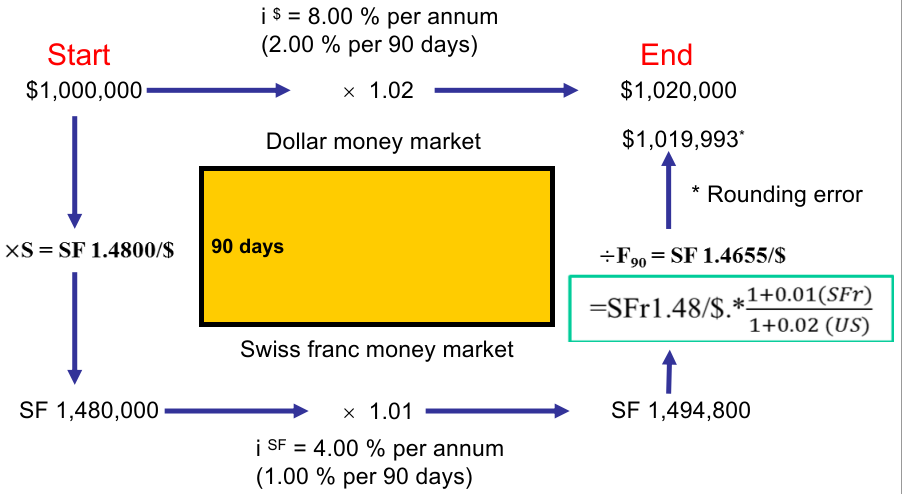
Covered Interest Arbitrage (CIA) - occurs whenever IRP does not hold
- Borrow the domestic currency
- Exchange the domestic currency for the foreign currency in the spot market
- Invest the foreign currency in an interest-bearing instrument
- Sign a forward contract to "lock in" a future exchange rate at which to convert the foreign currency proceeds back to the domestic currency
= 5%; = 8%; = 1.50 AUD/GBP; F = 1.48 AUD/GBP; Can arbitrage profits be made?
- F(AUD/GBP) = (1.5 AUD/GBP) * (1+0.05) / (1+0.08) = 1.4583 AUD/GBP
- GBP Overvalued (1.48 > 1.4583)
- Strategy: Sell GBP, buy AUD in the forward market
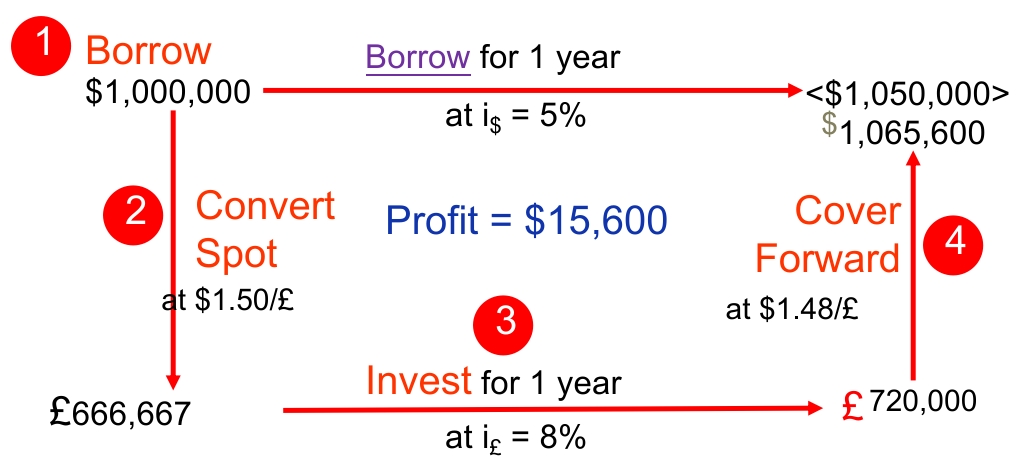
Covered Interest Arbitrage will bring the market back toward equilibrium
- Purchase of GBPs in the spot market will increase the spot rate (AUD/GBP) and sale of GBPs in the forward market will decrease forward rate on pound (AUD/GBP)
- The demand for pound-denominated securities causes the pound interest rates to fall, while the higher level of borrowing in Australia causes dollar interest rates to rise
Foreign Exchange Expectations
The Forward Rate as an Unbiased Predictor of the Future Spot Rate
The forward exchange hypothesis states that the forward exchange rate, quoted at time t for delivery at time t+1, is equal to the expected value of the spot exchange rate at time t+1
An unbiased predictor:
- does not mean the future spot rate will actually be equal to what the forward rate predicts.
- means that the forward rate will, on average, overestimate and underestimate the actual future spot rate in equal frequency and degree.
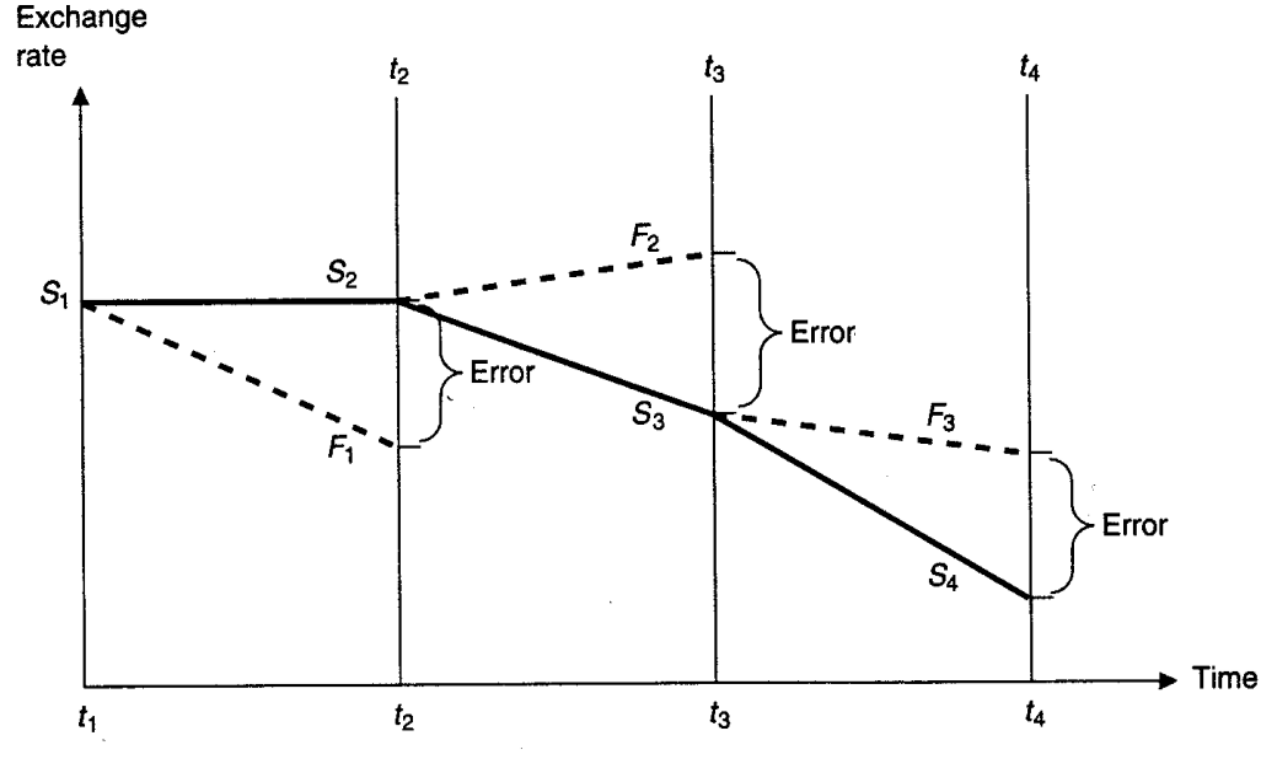
Uncovered Interest Rate Parity
A deviation from CIA is uncovered interest arbitrage (UIA) wherein investors borrow in currencies exhibiting relatively low interest rates and convert the proceeds into currencies which offer higher interest rates
- e.g. Yen carry trade
The transaction is "uncovered" because the investor does not sell the currency forward, thus remaining uncovered to any risk of the currency deviating
In an uncovered position, rather than locking in a forward rate today, you take your chances and hope you're right about your assessment of the future spot rate
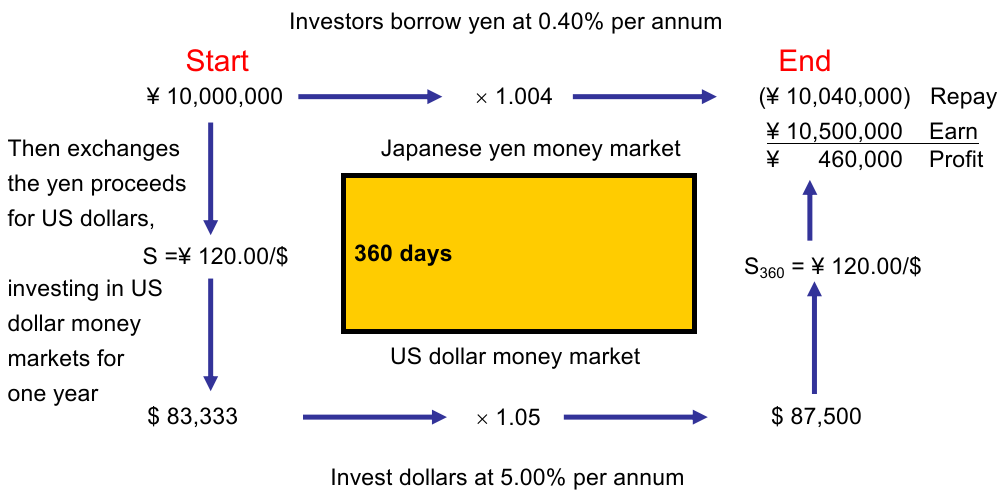
L4 - Balance of Payments
The Balance of Payments (BOP) is a statistical record of the flow of all of the payments between the residents of a country and the rest of the world in a given year.
Current Account
- Net exports/imports of goods and services
- Balance of Trade
- Net Income
- investment income from direct portfolio investment
- employee compensation
- Net transfers
- sums sent home by migrant and permanent workers abroad
Capital Account
- Capital transfers related to purchase and sale of fixed assets such as real estate
Financial Account
- Net foreign direct investment
- Net portfolio investment
- Other financial items
Net Errors and Omissions
- Missing data such as illegal transfers
Reserves and Related Items
- Changes in official monetary reserves including gold and foreign exchange reserves
The Current Account (CA)
CA = goods and services + unilateral transfers
CA is divided into 3 sub-categories:
- Merchandise Trade: physical goods like beef, cars etc.
- Services: interest payments, dividends, consulting etc.
- Unilateral transfers: foreign aid, wages repatriated
CA = Exports (X) - Imports (M)
- CA Deficit: M > X (CA < 0)
- CA Surplus: M < X (CA > 0)
CA Balance = Change in Net Foreign Wealth / Assets
The Capital Account (KA) / Financial Account
KA includes all short- and long-term financial transactions pertaining to both international trade and flows associated with portfolio shifts (stocks, bonds etc.)
The two main categories:
- Portfolio investment
- Direct investment
- takeover or acquiring a substantial portion of a foreign company
KA = Capital Inflow (cr) - Capital outflow (dr)
KA balance = Sum of portfolio investment and direct investment
CA and KA Example
Dell sells $20 mil of computers to Komatsu, a Japanese manufacturer of construction and mining equipment. Komatsu transfers dollars from its dollar-denominated bank account at Citibank in New York? What are the credit and debit items on the US balance of payments?
- Computer exports (CA): $20 mil (cr)
- Citibank foreign deposits decrease (KA outflow): $20 mil (dr)
LVMH, a French luxury goods buys EUR1.5 mil of consulting services from Boston Consulting Group (BCG). The firm writes a check on its euro-denominated bank account at different Paris Bank, BNP Paribas. What are the credit and debit items on the French balance of payments?
- Purchase of consulting services (CA): EUR1.5 mil (dr)
- BNP deposits (KA): EUR1.5 mil (cr)
Indonesian resident invested in Japanese bonds. Each year, she receives Yen500,000 coupon payments. These payments are deposited into her Tokyo Bank account. What re the credit and debit items on Indonesian BOP?
- Coupon receipts from Japanese Treasury (CA): Yen500,000 (cr)
- Tokyo Bank, foreign deposits (KA): Yen500,000 (dr)
Japanese firm gifts $2 million to a US University to create an endowed chair professor. The firm finances the gift by selling US Treasury Bonds. What are the debit and credit items on the Japanese BOP?
- Gift (CA): $2 mil (dr)
- Import Good Will
- Sale of US Treasury Bonds (KA): $2 mil (cr)
CA = -KA (This will hold approximately for floating rate countries)
Current & Capital Accounts (1982-2015)
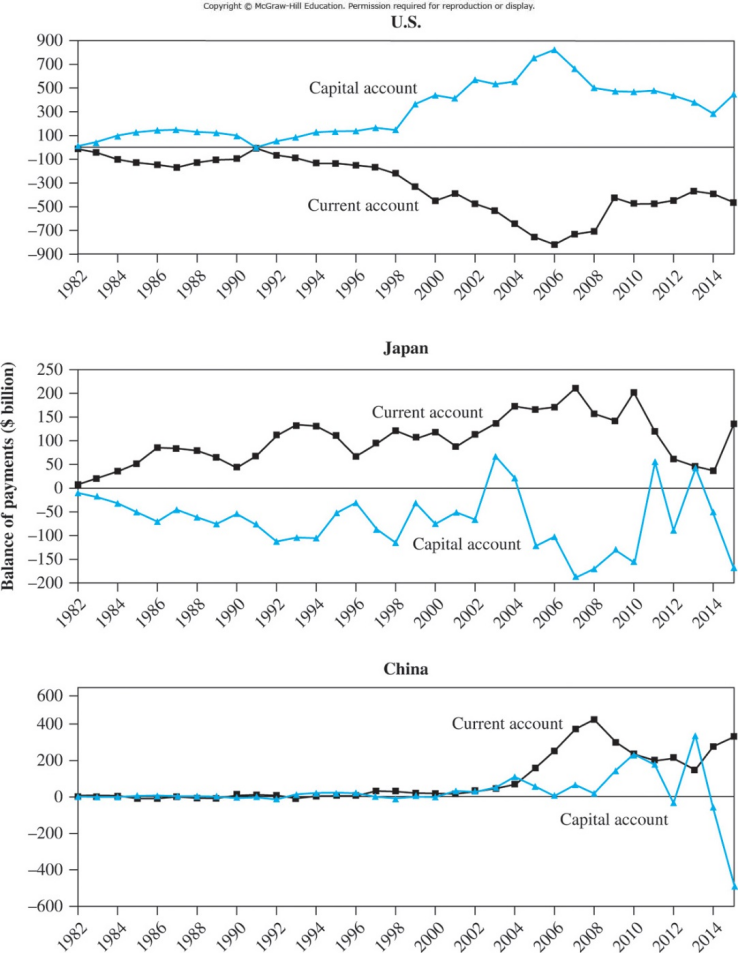
The Other Accounts
- Net Errors and Omissions (Balancing Item)
- account for statistical errors and/or untraceable monies within a country
- Official Reserves - total reserves held by official monetary authorities within a country
- Typically comprised of major currencies that are used in international trade and financial transactions and reserve accounts (SDRs) held at the IMF
- Important account for fixed-rate regime countries
- For floating rate regime countries, such as the U.S., official reserves relatively unimportant
The Trade and Devaluation: J-Curve
J-Curve
- A real depreciation makes imports look expensive and exports competitive
- However, the change in spending patterns takes time
- In the interim, we have nearly the same level of imports and exports
- But the price of imports relative to domestic output has increased, causing a decline in the trade balance
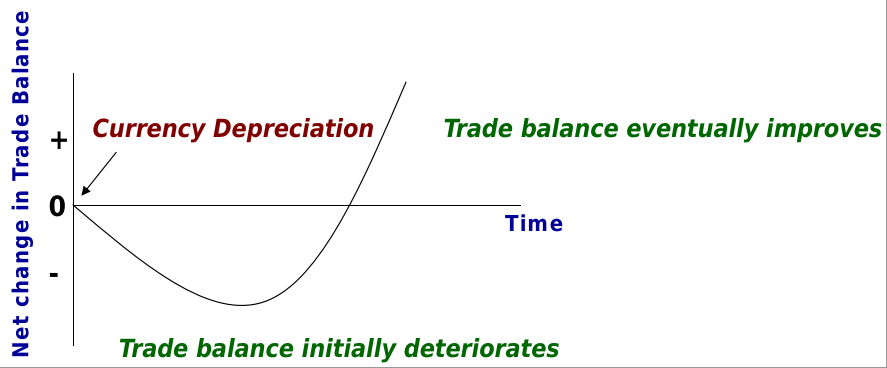
The J-curve adjustment process
- The currency contract period
- the pass-through period
- the quantity adjustment period
Export (X) - Import (M) =

Natural resource curse (Dutch disease)
- Demand for a particular product pushes up the demand for the currencies causing real appreciation
- Exports from other industries lose competitiveness (crowd-out effect)
- Temporary current account surplus might lead to persistent current account deficit
- This is the problem for resource rich countries (Norway, Saudi, Timor Leste)
Solution: Sovereign wealth fund (set up a fund and buy international asset)
- Public Investment Fund (Saudi Arabia)
- Government Pension Fund of Norway
Private Savings = National Income – Consumption – Taxes = Y - C - T
PS = (C + I + G + X - M) - C - T
(PS – I) + (T – G) = X – M = CA
Savings surplus + Govt. surplus = Exports – Imports = CA balance
CA Deficit = a country is not saving enough to finance its domestic investment + government budget deficit
- represents a collective national decision to consume and invest more than the nation is producing
Sustainability of CA Deficits
- A growing economy can expect to run a current account deficit (CAD)
- Countries that have large investment opportunities can run large current account deficits
- Sometimes it makes sense to borrow abroad temporarily (CA = S – I)
- The absolute level of both savings and investment are important
- A CAD caused by low savings (high consumption spending) is less likely to be sustainable than a CAD because of high investment
- higher investment increases future production capacity and the ability to pay back foreign liabilities
- Composition of Investment Spending is important (CA = X - M)
- The more the investment is in traded goods, then more likely to generate trade surpluses
- The manner in which CA deficits are financed matters
L5 - Foreign Currency Derivatives
Futures vs. Forwards
| Futures Contracts | Forwards Contracts | |
|---|---|---|
| Markets | Prices determined in centralized exchanges | Decentralized inter-bank market |
| Trading Hours | Most trading during exchange hours | Open somewhere around the world |
| Contract Size | Standardized sizes depending on currency | Standard size of $1m etc. & can be tailored |
| Contract Maturity | Fixed delivery dates: 3rd Wed. of March, June, Sept. or Dec. | Fixed maturities (1, 3, 6 or 12 months) or can be tailored to specification |
| Quotation | American terms (US/FC) | American (US/FC) or European (FC/US) |
| Settlement | Delivery of underlying fx is feasible, but almost never occurs. Position closed out by taking an offsetting position | Delivery of foreign exchange normally takes place. |
| Security against default | Clearing houses stand behind traders | Assets of bank |
| Required collateral | Margin requirements ("Performance Bond") | Deposit required if no standing relations with bank |
| Cash flows | Occur daily because of "marking-to-market" feature | No cash flows until forward contract matures |
Forwards
At A$ 1.80/US$ - USD 1m will exchange for $1.90 at a time when the buyer can buy spot at A$ 1.80 - buyer could default.
At A$ 2.00/US$ - USD 1m will exchange for $1.90 at a time when the seller could receive spot at A$ 2.00 - seller could default.
At A$ 1.90/US$ there is no difference
Forwards Payoff
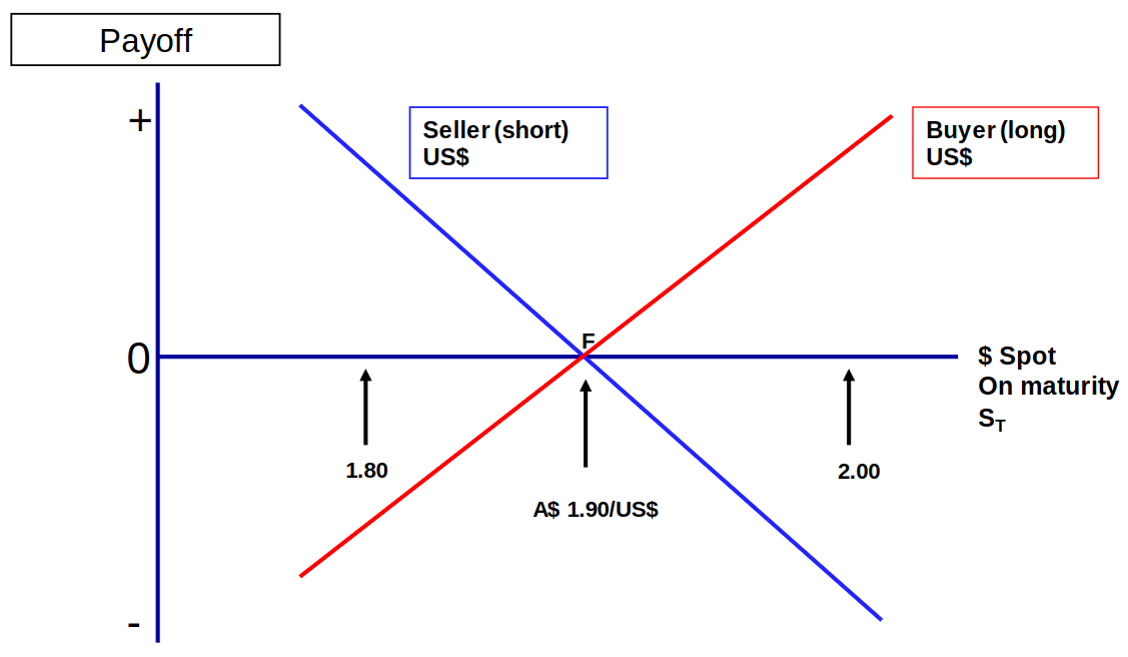
Value of Forward Purchase at Expiration (US$/SF)
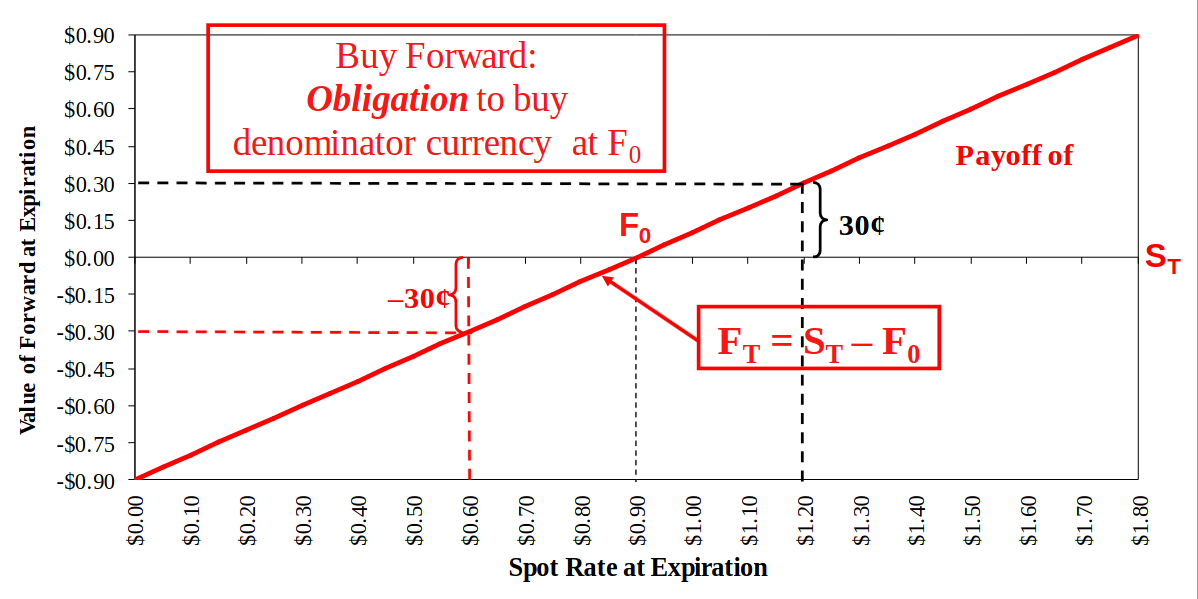
Value of Forward Sale at Expiration (US$/CHF)
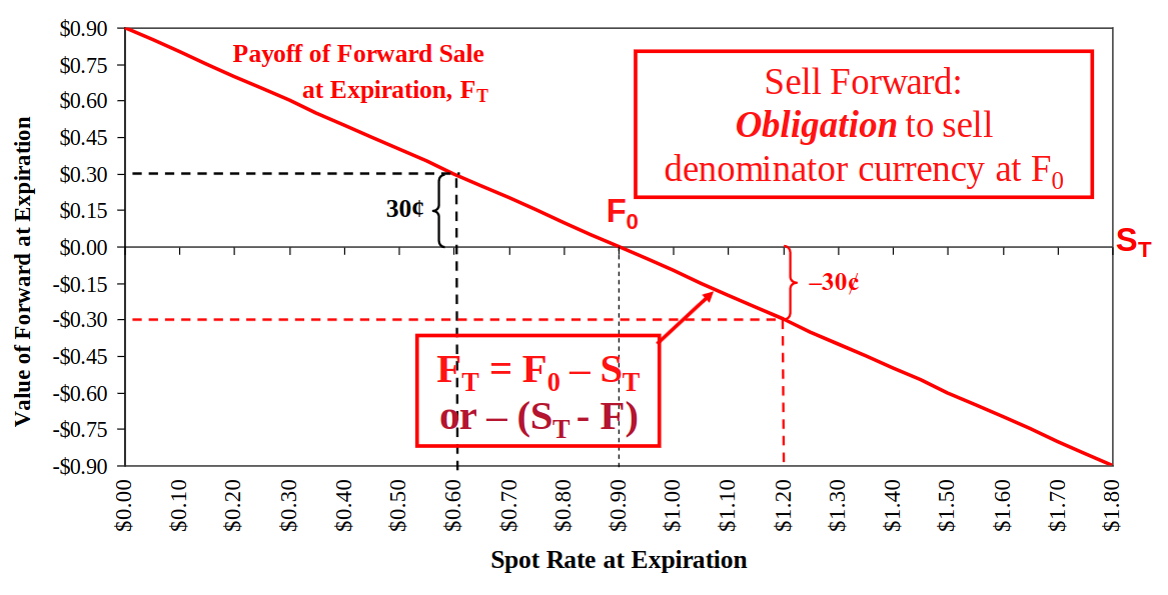
Foreign Currency Options (Call / Put)
Options give the option holder the right, but not the obligation to buy or sell the a specified amount of the underlying asset (currency) at a pre-determined price (exercise or strike price)
Types of Options
- Call: gives the holder the right to buy denominator currency
- Put: gives the holder the right to sell denominator currency
- American option: exercise the option at any time
- European option: exercise only on the expiration date, not before
exercise / strike price (X): the exchange rate at which foreign currency can be purchased (call) or sold (put)
Payoff of Call Option at Expiration (US$/CHF)
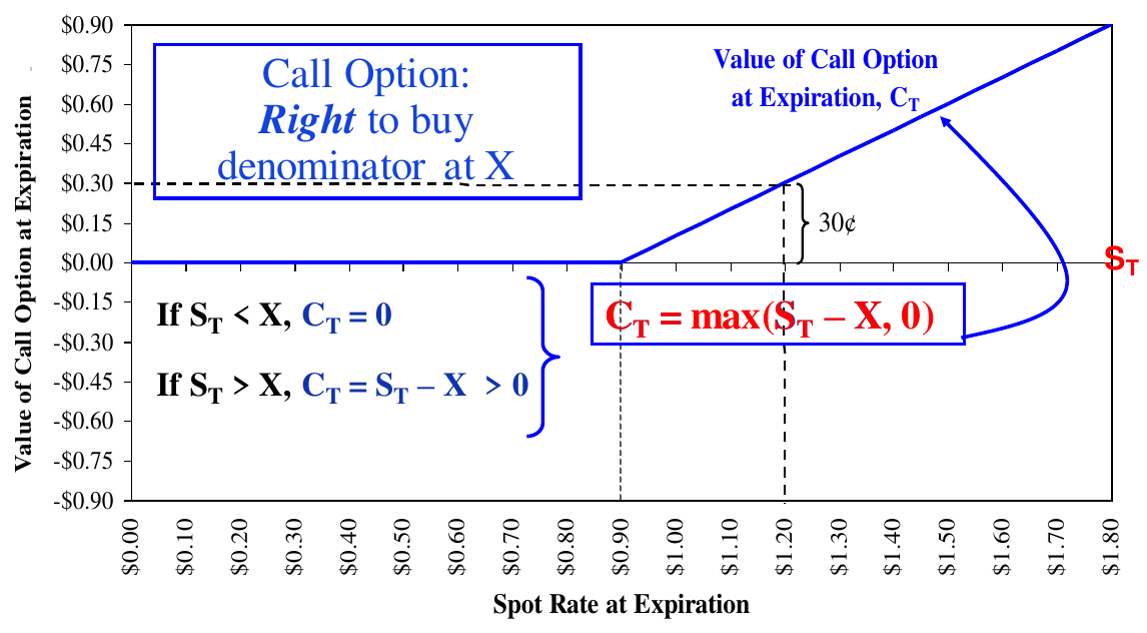
Payoff of Put Option at Expiration (US$/CHF)
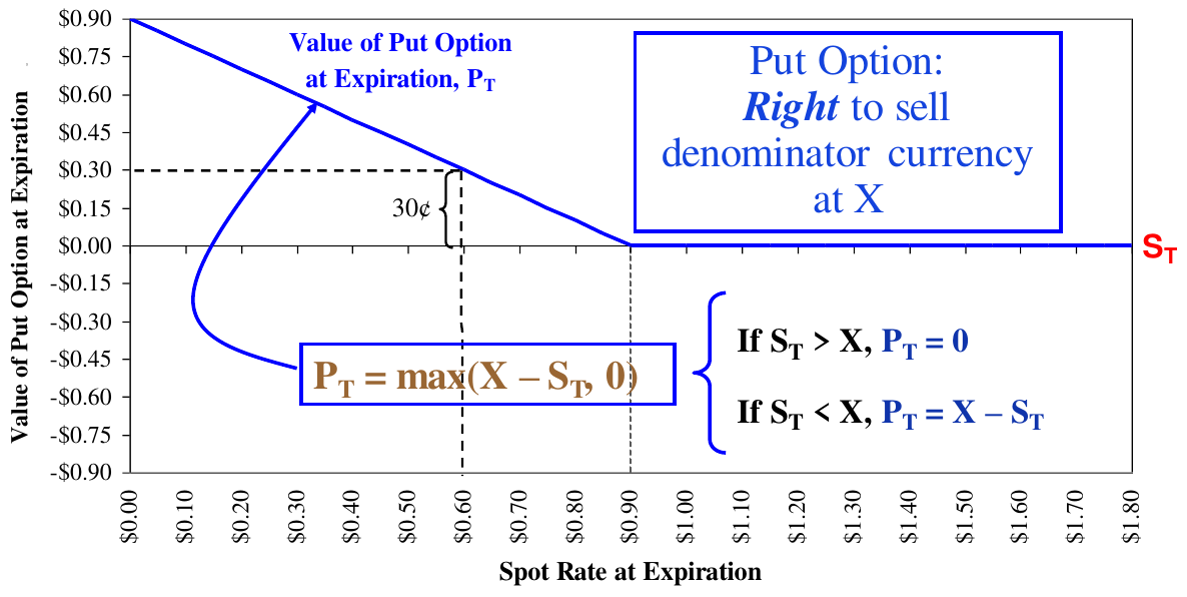
Long Call CHF = Long Put USD
Long Put CHF = Long Call USD
Intrinsic and Time Value
| Call | Put | |
|---|---|---|
| Intrinsic value | max( - X, 0) | max(X – , 0) |
| in the money | – X > 0 | X – > 0 |
| at the money | – X = 0 | X – = 0 |
| out of the money | – X < 0 | X – < 0 |
| Time Value | C – Int. value | P – Int. value |
C = Call premium; P = Put premium
Factors that Affect Options Prices
- current exchange rate (S): as S↑, Call price↑ and Put price↓
- strike price (X): as X↑, Call price↓ and Put price↑
- time to expiration (T): as T↑, the value↑
- volatility of the exchange rate (σ): the higher the σ of the exchange rate, the greater the value
- domestic interest rate (): as ↑, Call price↑ and Put price↓
- foreign interest rate (): as ↑, Call price↓ and Put price↑
Summary
Put Call Parity:
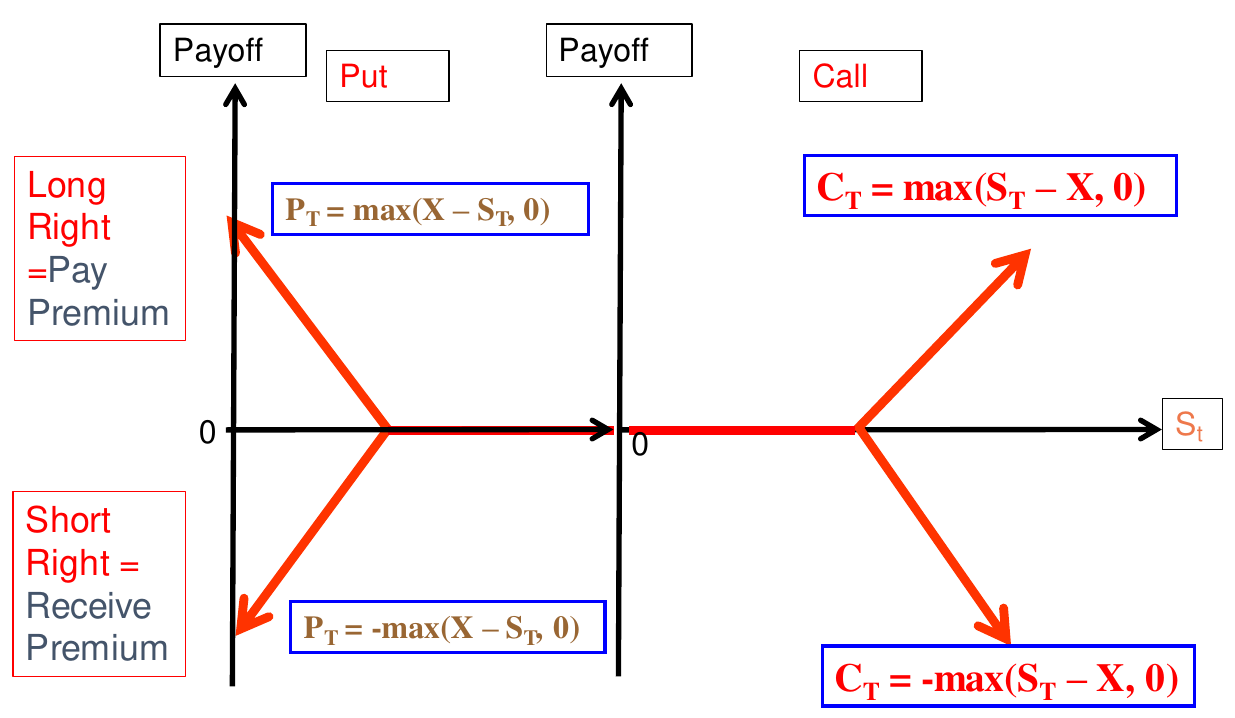
Currency Swaps
Swap: a contractual agreement to exchange periodic cash flows between two parties
Single currency interest rate swap: One counterparty exchanges the interest payments of a floating-rate debt obligation for the fixed-rate interest payments of the other counterparty. Both debt obligations are denominated in the same currency
Cross-currency interest rate swap: One counterparty exchanges the debt service obligations of a bond denominated in one currency for the debt service obligations of the other counterparty denominated in another currency
Swap Bank - financial institution that facilitates swaps between counterparties
The swap bank serves as either a broker or a dealer
- A broker matches counterparties but does not assume any of the risk of the swap
- The swap broker receives a commission for this service
- Today most swap banks serve as dealers or market makers
- The swap bank stands willing to accept either side of a currency swap
Interest Rate Swap Example 1
- Bank A is a AAA-rated international bank located in the U.K. that wishes to raise $10,000,000 to finance floating-rate Eurodollar loans.
- Bank A is considering issuing 5-year fixed-rate Eurodollar bonds at 10 percent.
- It would make more sense for the bank to issue floating-rate notes at LIBOR to finance the floating-rate Eurodollar loans.
- Bank A prefers to borrow at float-rate.
Interest Rate Swap Example 2
- Company B is a BBB-rated U.S. company. It needs $10,000,000 to finance an investment with a five-year economic life, and it would prefer to borrow at a fixed rate.
- Firm B is considering issuing 5-year fixed-rate Eurodollar bonds at 11.75%.
- Alternatively, Firm B can raise the money by issuing 5-year floating rate notes at LIBOR + 1/2%.
- Firm B would prefer to borrow at a fixed rate.
The borrowing opportunities of the two firms are shown in the following table:
| COMPANY B | BANK A | DIFFERENTIAL | |
|---|---|---|---|
| Fixed rate | 11.75% | 10% | 1.75% |
| Floating rate | LIBOR + 0.50% | LIBOR | 0.50% |
To see the potential advantages to a swap, imagine the two entities trying to minimize their combined borrowing costs:
| COMPANY B | BANK A | DIFFERENTIAL | |
|---|---|---|---|
| Borrow preferred method | 11.75% | LIBOR | LIBOR + 11.75% |
| Borrow opposite & swap | LIBOR + 0.50% | 10% | LIBOR + 10.50% |
NET POTENTIAL SAVINGS: 1.25%
- Bank A has an absolute advantage in borrowing relative to Company B
- Nonetheless, Company B has a comparative advantage in borrowing floating
- while Bank A has a comparative advantage in borrowing fixed
- A & B together can borrow more cheaply if Bank A borrows fixed, while Company B borrows floating
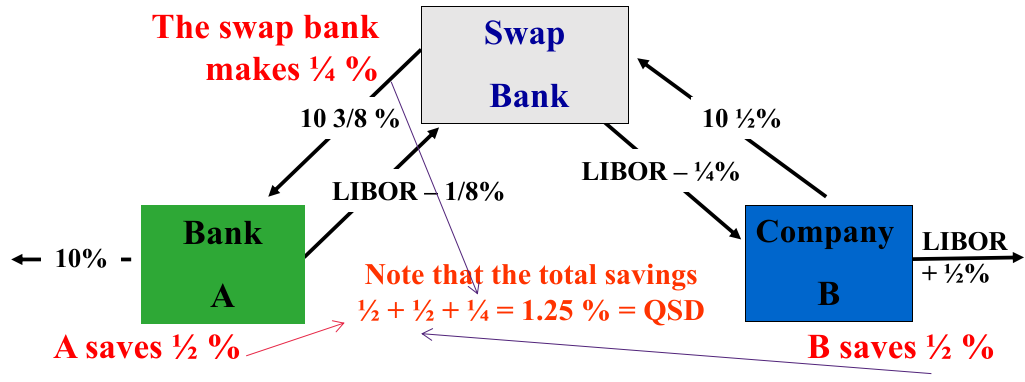
The swap bank makes this offer to Bank A:
- You pay LIBOR - 1/8 % per year on $10 million for 5 years
- We will pay you 10 3/8% on $10 million for 5 years
- With the swap, Bank A pays LIBOR - 1/2%
- +(10 3/8%) - 10% - (LIBOR-1/8%) = -(LIBOR-4/8%) = pay (LIBOR-1/2%)
- Save 0.5% compared to LIBOR
The swap bank makes this offer to Company B:
- You pay us 10 1/2 % per year on $10 million for 5 years
- We will pay you LIBOR – 1/4 % per year on $10 million for 5 years
- With the swap, Company B pays 11 1/4%
- LIBOR – 1/4% - (10 1/2%) - (LIBOR + ½%) = - (11 1/4%)
- Save 0.5% compared to initial preference 11.75%
Note that the total savings 1/2 + 1/2 + 1/4 = 1.25 % = QSD
- Therefore The swap bank makes 1/4 %
The Quality Spread Differential (QSD)
- QSD represents the potential gains from the swap that can be shared between the counterparties and the swap bank.
- There is no reason to presume that the gains will be shared equally.
- In the above example, Company B is less credit-worthy than Bank A, so they probably would have gotten less of the QSD, in order to compensate the swap bank for the default risk.
Foreign Currency Swaps
Firm A is a U.S.-based MNC and Firm B is a U.K.-based MNC. Firm A wants to finance a £10,000,000 expansion of a British plant. Spot rate is = 1.60 USD/GBP
- They could borrow dollars in the U.S. where they are well known and exchange dollars for pounds
- This results in exchange rate risk
- They could borrow pounds in the international bond market, but pay a lot since they are not well known abroad
- Therefore, Firm A needs to find a British firm wanting to finance dollar borrowing in the amount of $16,000,000.
| Currency | Company A (US) | Company B (UK) |
|---|---|---|
| Company A (US) | 8.0% | 10.0% |
| Company B (UK) | 11.6% | 12.0% |
| Diff (B-A) | 2.0% | 0.4% |
Two Methods:
- Preferred Method: 21.6% = 10% + 11.6%
- Borrow Opposite and Swap: 20% = 8% + 12%
A has absolute advantage in borrowing both $ and £
- A is the more credit-worthy of the two.
- A pays 2% less to borrow in dollars than B.
- A pays 0.4% less to borrow in pounds than B.
B has a comparative advantage in borrowing in £
- B pays 2% more to borrow in dollars than A.
- B pays only 0.4% more to borrow in pounds than A.
QSD = 2% - 0.4% = 1.6%
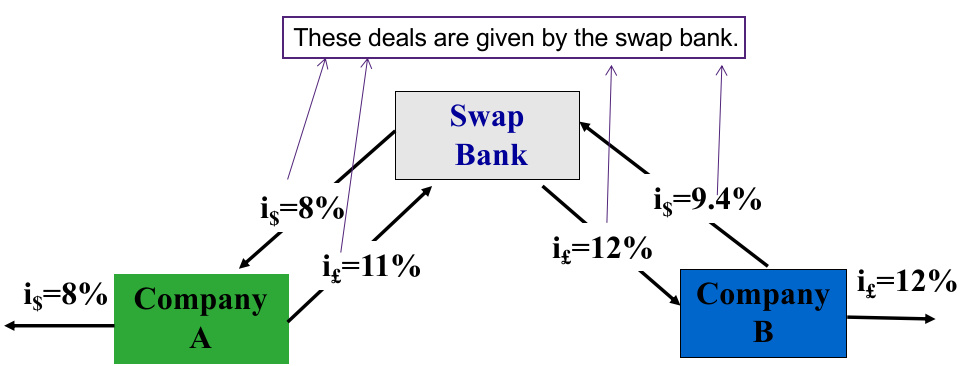
A(0.6%) + B(0.6%) + Swap Bank(0.4%) = 1.6% QSD
- A saves = 0.6%
- A's net position is to borrow at = 11%
- B saves =0.6%
- B's net position is to borrow at =9.4%
- The swap bank makes 0.4%
- 1.4% of USD 16 million financed with 1% of GBP 10 million per year for 5 years.
- 1.4% x USD 16mil - 1% x GBP 10mil x 1.6 USD/GBP
- At = 1.60 USD/GBP, that is a gain of USD 64,000 (=0.4% * USD 16mil) per year for 5 years.
- The swap bank faces exchange rate risk, but maybe they can lay it off in another swap.
Variations of Basic Swaps
Currency Swaps
- fixed for fixed
- fixed for floating
- floating for floating
- amortizing
Interest Rate Swaps
- zero-for floating
- floating for floating
For a swap to be possible, a QSD must exist
Unwinding a Swap
Discount the remaining cash flows under the swap agreement at current interest rates, and then (in the case of a currency swap) convert the target currency back to the home currency of the firm.
Payment of the net settlement of the swap terminates the swap.
L6 - Transaction and Translation Exposures
Transaction exposure
Transaction exposure - measures gains or losses that arise from the settlement of existing financial obligations (e.g., account receivables, account payables) whose terms are stated in a foreign currency.
Example: firm that has signed a contract to ship goods overseas at a fixed foreign currency price
- €1,800,000, payment to be made in 60 days
- S0 = $0.9000/€
- If the euro weakens to $0.8500/€, then firm will receive $1,530,000 (€1.8mil * $0.85/€)
- If the euro strengthens to $0.9600/€, then firm will receive $1,728,000 (€1.8mil * $0.96/€)
- exposure is the chance of either a loss or a gain
Inflows of FC
- Accounts receivable denominated in a foreign currency (FC)
- Long-term sales contracts denominated in a FC
- Deposits, bonds, or notes denominated in a FC
- Forward purchase of a FC
Outflows of FC
- Accounts payable denominated in a FC
- Long-term purchase con-tracts denominated in a FC
- Loans, bonds, or notes due denominated in a FC
- Forward sales of a FC
Net Exposure by currency and date = Total Inflows – Total Outflows
Value at Risk (VaR)
VaR – To estimate the potential maximum loss (over a certain period) on the value of positions that are exposed to exchange rate movements
Example: A firm has €10m position (receivable). The current spot rate is $1.20/ €. Normal distribution with μ = 0 and σ = 6% per month. What is its VaR?
- x = μ – 1.65 * σ (the 5% tail probability of adverse move starts at 1.65 standard deviation below the mean)
- x = 0 – 1.65 * 0.06 = - 0.099
- VaR = -0.099 * $12m = –$1,188,000
Hedge Strategy
Hedging protects from loss, but also eliminates any gain
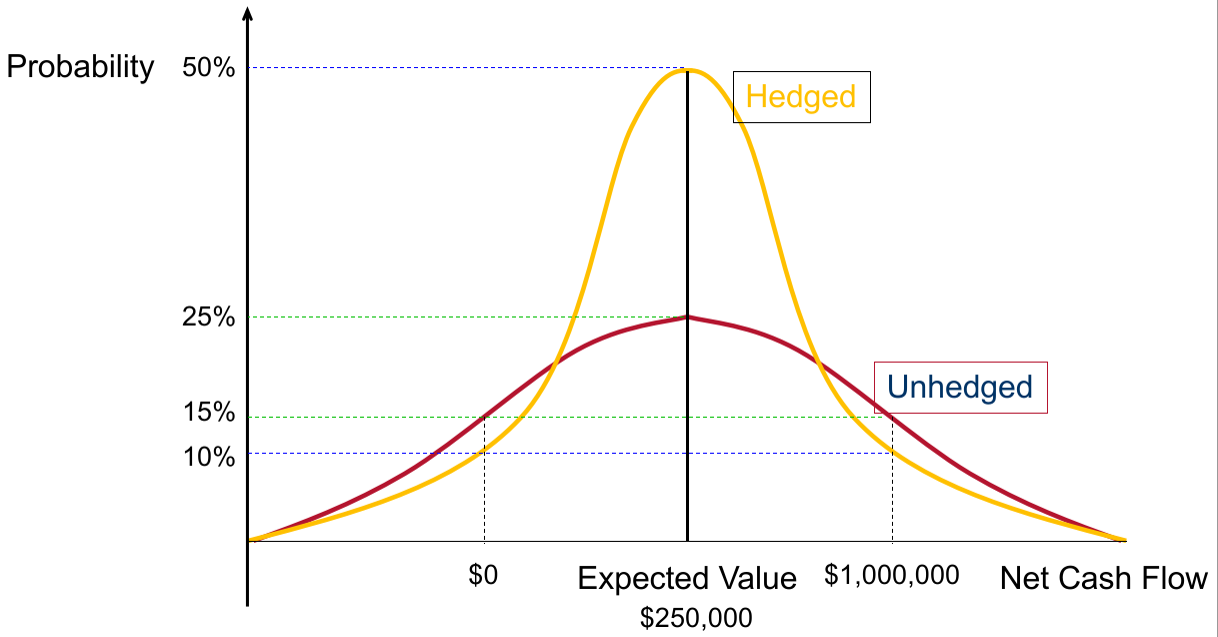
Hedging reduces expected tax if taxes are convex rather than linear functions of income
Suppose that income:
- ≤ $10m, tax rate = 20%
-
$10m, tax rate = 40%
Income:
- Good State (50%) = $15m
- Bad State (50%) = $5m
Don't Hedge, E(Tax) = 0.5 * [($10m * 20%) + ($5m * 40%)] + 0.5 * ($5m * 20%) = $2.5m
Hedge, E(Tax) = 1.0 * $10m * 20% = $2m
Transaction exposure can be managed by
- Contractual Hedges: Forward, Options, and Money Markets
- Operating and Financial Hedges: Risk-Sharing Agreements, Leads and Lags in Payment Terms, Swaps and Other Strategies
Hedging of Receivables
- Sell futures or forward
- Buy Put Option
- Money market hedge
- borrow foreign currency to be received
- convert to domestic currency
- invest for future use (domestic currency)
- Note: Fear of FC depreciating in value
Hedging of Payables
- Buy futures or forward
- Buy Call Option
- Money market hedge
- borrow domestic currency
- convert to foreign currency
- invest for future use (foreign currency)
- Note: Fear of FC appreciating in value
Alternate Hedging Strategies
- Risk Shifting
- Leading and lagging
- leading (accelerate timing of depreciating currency receivables)
- lagging (delay timing of appreciating currency receivables)
- Currency Risk Sharing
- Cross-hedging
- Currency diversification
Note: Options are more flexible hedging devices than forwards and futures in the sense that the forward contract must be exercised
Hedge Example
Assume Boeing is expected to receive 10m GBP (£) in one years time
Available Information:
- one-year forward rate: US$1.46/£
- spot rate: US$1.50/£
- put option on pounds with strike of US$1.46 has a premium of US$0.02
- interest rates:
- US: 6.10% per annum
- UK: 9.00% per annum
IRP:
F = (USD1.50/£) * (1+0.061)/(1+0.09) = USD1.46/£
Forward Hedge
Forward Hedge - By selling GBP forward, Boeing locks in the US$ receivable at $14.6m (£10m * $1.46/£)
Gain/Loss from forward hedging: (F – ST) * FC hedged
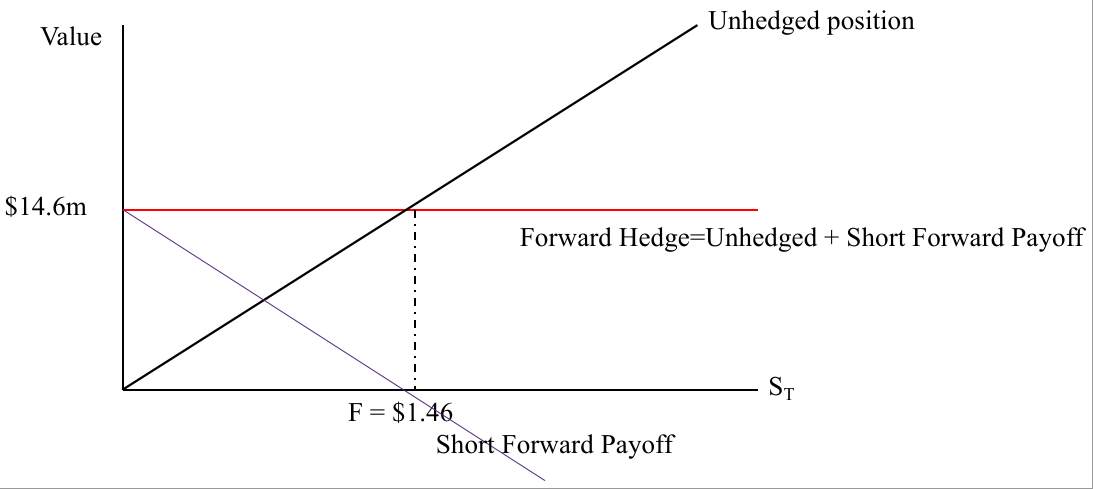
Options Hedge
Options Hedge: Long Put - Has the right to sell £ @ $1.46/GBP
- will receive $14.6m if exercised
Note: A premium of $200,000 (£10m * $0.02) was paid up-front
- We need to take into account time-value of money.
- The upfront cost is actually $212,200 ($200,000 * 1.061) in one years time.
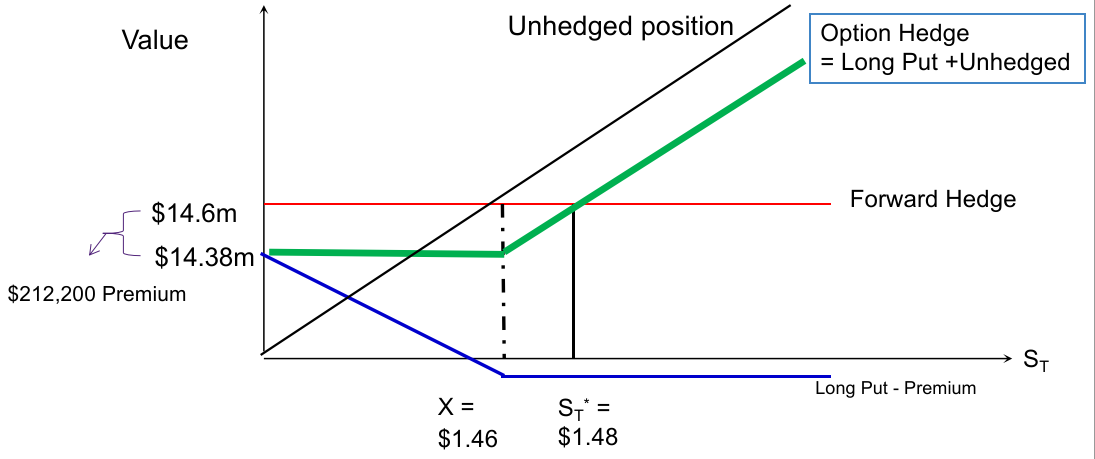
Money Market Hedge
Money Market Hedge - Borrow (or lend) in the foreign currency to hedge its foreign currency receivables (payables)
- match FC assets & liabilities in the same currency
Boeing's Money Market Hedge
- Borrow the PV of £10m at 9% (£ 9,174,312)
- Convert £ into $ at $1.50/£ ($13,761,468)
- Invest $ in the US at 6.1% for one year ($14,600,918)
- Collect £10m in one-year and repay the loan (the £ receivable offsets the loan)
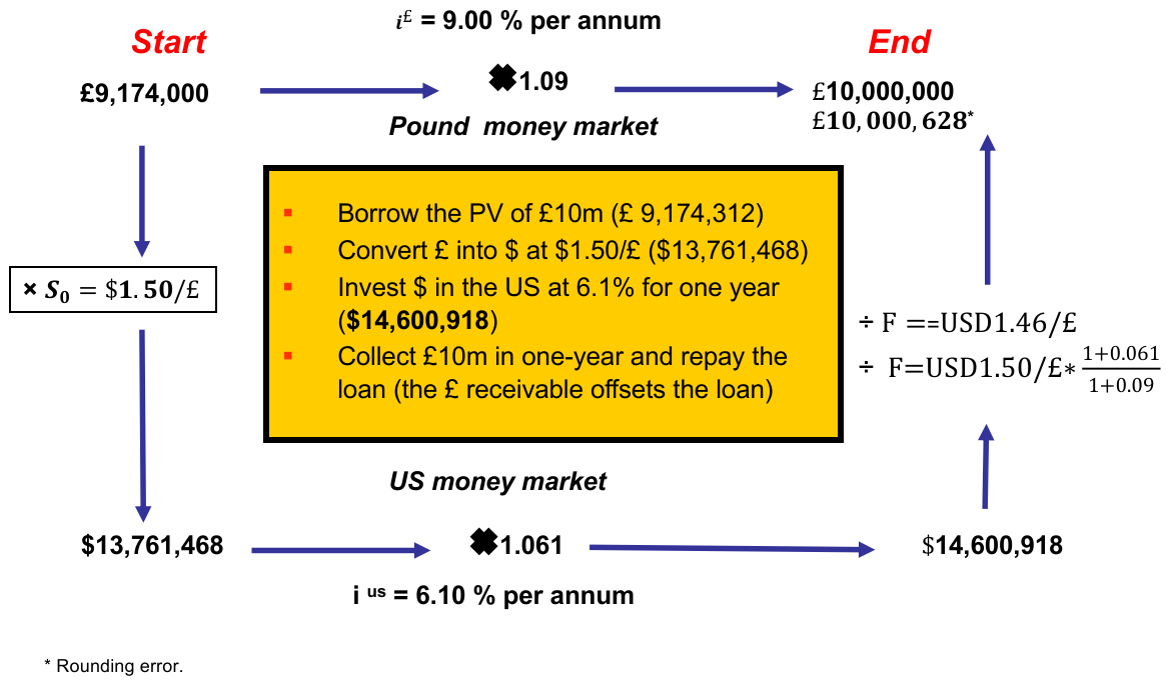
Translation (Accounting) Exposure
For Multinational corporations, financial statements need to be converted into the home currency when consolidated
Accounting Rules for Translation
- Current/Non-current Method
- Monetary/Non-monetary method
- Temporal method
- Assets & liabilities: Translated at the historical exchange rate if they are recorded at historical cost
- Revenue & expense items: Translated at the historical exchange rate or at the average rate if there are multiple transactions of a similar nature
- Current rate method
- Assets & liabilities: Translated at the current exchange rate
- Revenue & expense items: Translated at their historical rates (or at an average rate if there are multiple transactions)
Translation rates:
- Current (exchange) rate
- Historical (exchange) rate
- Average (exchange) rate
The most common way to hedge is a balance sheet hedge in which the company has equal amounts of assets and liabilities in each currency that offset each other and leave the company without any translation exposure.
L7 - Economic Exposure
Economic / Operating Exposure
Economic / Operating Exposure – the impact of currency fluctuations on a firm's future cash flows
- the extent of sensitivity of the Market Value of a firm (or a portfolio of securities) to exchange rate movements
Cash flows () can be disentangled into its various constituents that can be denominated in several currencies.
This exposure can be denoted as:
where
It measures the marginal impact on firm value by a change in the ($A/FC) exchange rate.
The Source of Economic Exposure
Economic exposure arises when the value of the firm is affected by changes in the Real exchange rate.
Exchange rates affect the value of the firm through their impact on
- Revenues
- Costs and
- Competitive position
Note: if a change in the exchange rate merely reflects differential rates of inflation between countries, then relative prices would not change and the value of the firm would be unaffected
Cash flows can be further decomposed into:
- Sales/Revenues = Price * Quantity
- Costs = Fixed + Variable * Number of goods produced
Conduits for Economic Exposure
Perfectly Elastic Demand: Demand elastic. To maintain market share, absorb all cost increases (no pass-through). Profit margins fall.
Perfectly Inelastic Demand: Demand inelastic, pass-through all cost increases, maintain/improve margins.
Elastic Demand: Demand elastic, absorb some of cost increase, lose both market share and profit margins.
Impact of Exposure can be DIRECT or INDIRECT
- For example, AUD 1/£, HC=AUD; FC=£
| HC strengthens | HC weakens | |
|---|---|---|
| e.g., AUD 0.8/£ | e.g., AUD 1.3/£ | |
| Direct Exposure | ||
| Sales abroad (e.g., sell @ £10) | Unfavourable | Favourable |
| Source abroad(e.g., cost @ £1) | Favourable | Unfavourable |
| Profits abroad | Unfavourable | Favourable |
| Indirect Exposure | ||
| Supplier sources abroad | Favourable | Unfavourable |
| Competitor sources abroad | Unfavourable | Favourable |
Estimating Economic Exposure
Audits / Scenario Analysis: Qualitative examination of the separate elements of a firm's operating cash flow and anticipating its sensitivity to real exchange rate changes.
Statistical Approach: Regress changes in firm value on changes in exchange rates to obtain a quantitative assessment of sensitivity.
- Presumption is that changes in the value of a firms public securities measures the effect of exchange rate changes. (measure of aggregate exposure)
Managing Economic Exposure
Use of Marketing Strategies
- Market Selection
- Pricing Strategy/Product strategy
- Promotional Strategy
Use of Production Management
- Input mix
- Plant Location & Shifting production among plants
- Raising Productivity (i.e. lowering costs)
Natural Hedges
- Toyota has insulated itself to some extent against dollar fluctuations
- It builds 60% of the cars sold in North America
- Michelin, the world's largest tire maker, has 40% of its annual sales in North America.
- Most of the imported raw materials used by Michelin are also priced in dollars
- BMW has created natural hedges by producing cars in America and Britain
- It opened a factory in S. Carolina in 1994 and produced 160,000 vehicles there in 2003.
Transactional Hedges
- Unlike BMW, Porsche makes most of its cars in Germany, so its costs are mostly in euros
- Yet a large chunk of revenues come from sales of sports cars in America
- Unlike BMW, Porsche has no natural hedge
- Thus, Porsche uses financial hedging
- Porsche says they are "100% hedged" against the dollar through 2007
(Lack of) Transactional Hedges
- Volkswagen attributed most of its 1.2 Billion euro losses in 2003 to currency swings it had not hedged against
- This had a 'real effect' as it announced plans to cut 5000 jobs.
- It has since 'stepped up its hedging' to 70% of its exposure. (NY Times Jan. 17, 2004 & Mar. 9, 2004)
Exchange Rate Changes and Profit Margins
Foreign customers do observe exchange-rate driven changes in prices, but the Japanese firms moderate the extent of these changes by altering their profit margins.
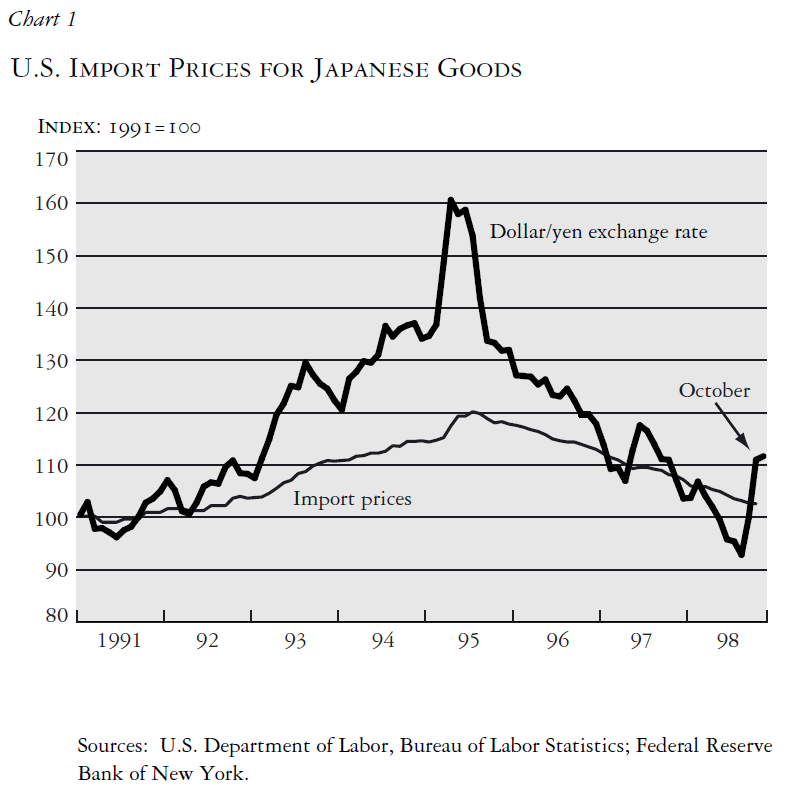
A Real World Example – Honda Motors
- Honda used to manufacture all its automobiles in Japan and ship them to the U.S.
- U.S. demand declined with yen appreciation
- In January 1993, exchange rate was about 125 ¥/$ (¥1,250,000)
- By April, it fell to 113‑114 ¥/$ range (¥1,130,000)
- June 1993 dollar fell to about 110 ¥/$ (¥1,110,000)
- End of summer, 100 ¥/$ (¥1,000,000)
- With ¥ cost, Honda’s profit was significantly hurt.
L8 - International Diversification
Diversification
- Potential for higher expected returns
- Potential for lower portfolio risk
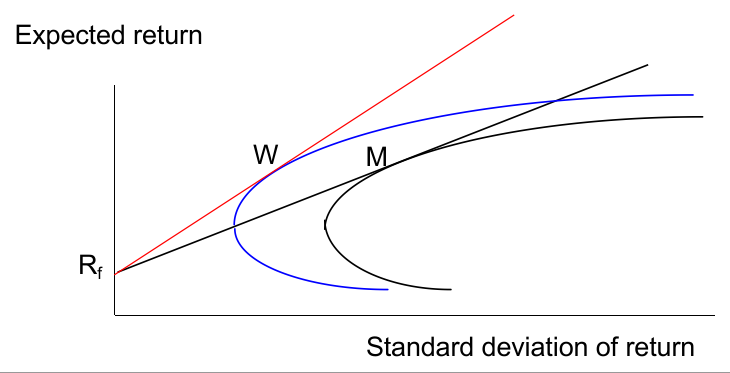
The Algebra of Portfolio
Assumptions
- Nominal returns are normally distributed
- Investors want more return and less risk as denominated in their home currency
wi = proportion of wealth devoted to asset i such that Si wi = 1
Expected return on a portfolio:
Portfolio Variance: where
Portfolio Variance (2 assets):
The N-asset Case and risk of an equally weighted portfolio:
| American | 14.30% | 16.40% |
| British | 17.60% | 29.90% |
| Japanese | 17.70% | 35.70% |
| A | B | J | |
|---|---|---|---|
| A | 1 | 0.557 | 0.325 |
| B | 0.557 | 1 | 0.317 |
| J | 0.325 | 0.317 | 1 |
Example: Equal weights of A and J
- = (1/2)(0.143) + (1/2)(0.177) = 16%
- = (1/2)2(0.164)^2 + (1/2)(0.357)^2 + 2(1/2)(1/2)(0.325)(0.164)(0.357) = 0.0481
- = (0.0481)^(1/2) = 21.9%
Key Results of Portfolio Theory
- Reduced risk depends on correlation of assets in portfolio
- As the number of assets increases, portfolio variance becomes:
- more dependent on the covariances (or correlations)
- less dependent on variances
Internationalising a Domestic Portfolio (A multiple-asset case)
Domestic Portfolio vs. International Portfolio
- An investor may choose a portfolio of assets enclosed by the domestic portfolio opportunity set
- The optimal domestic portfolio is found at DP (CML tangent to domestic portfolio opportunity set)
- The domestic portfolio with the minimum risk is
- An investor may choose a portfolio of assets enclosed by the international portfolio opportunity set
- The optimal international portfolio is found at IP (CML tangent to international portfolio opportunity set)
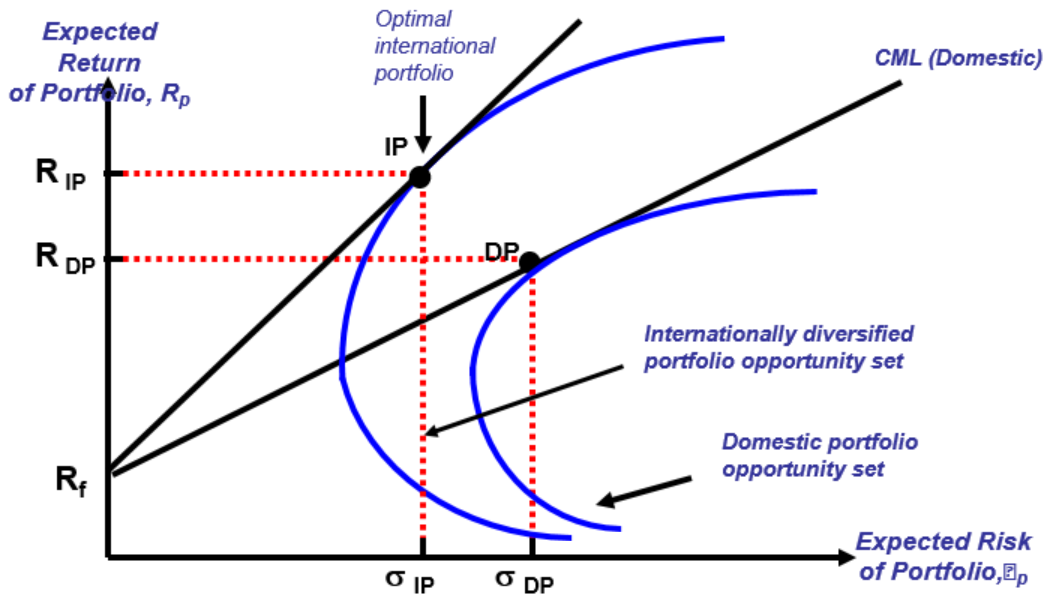
By diversifying the portfolio, the variance of the portfolio's return relative to the variance of the market's return (beta) is reduced to the level of systematic risk (the risk of the market itself)

A fully diversified international portfolio is only 12 percent as risky as holding a single security.
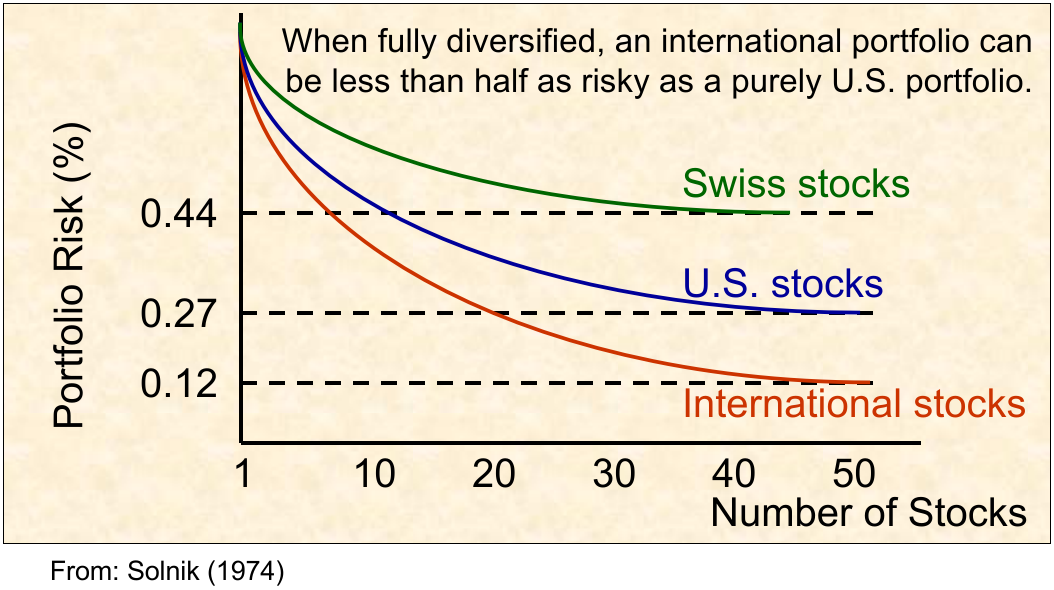
What drives correlations?
- Industry structures
- Australia and Canada
- economic integration
- Geography
- Germany and Switzerland
- financial integration
- Bad-time versus good-time correlation
- asymmetric correlations
Correlations of Monthly Returns with the US Market: Emerging Markets
| Country | 1989–2000 | 1989–1992 | 1993–1996 | 1997–2000 |
|---|---|---|---|---|
| Argentina | 0.24 | 0.16 | 0.45 | 0.50 |
| Chile | 0.31 | 0.13 | 0.19 | 0.54 |
| Colombia | N/A | N/A | -0.13 | 0.14 |
| Czech Republic | N/A | N/A | N/A | 0.21 |
| Egypt | N/A | N/A | N/A | 0.27 |
| Hungary | N/A | N/A | N/A | 0.56 |
| India | N/A | N/A | -0.07 | 0.20 |
| Indonesia | 0.33 | 0.08 | 0.50 | 0.45 |
| Israel | N/A | N/A | 0.43 | 0.37 |
| Jordan | 0.15 | 0.23 | -0.01 | 0.21 |
| Korea | 0.27 | 0.22 | 0.05 | 0.34 |
| Malaysia | 0.35 | 0.53 | 0.20 | 0.35 |
| Mexico | 0.45 | 0.35 | 0.25 | 0.69 |
| Morocco | N/A | N/A | N/A | -0.06 |
| Pakistan | N/A | N/A | -0.01 | 0.15 |
| Peru | N/A | N/A | 0.11 | 0.35 |
| Philippines | 0.40 | 0.40 | 0.16 | 0.51 |
| Poland | N/A | N/A | 0.20 | 0.40 |
| Russia | N/A | N/A | N/A | 0.58 |
| South Africa | N/A | N/A | 0.11 | 0.53 |
| Taiwan | 0.24 | 0.13 | 0.10 | 0.49 |
| Thailand | 0.45 | 0.40 | 0.29 | 0.54 |
| Turkey | 0.07 | -0.19 | 0.09 | 0.29 |
| Venezuela | N/A | N/A | -0.05 | 0.29 |
| Composite | 0.50 | 0.32 | 0.30 | 0.68 |
| Asia | 0.38 | 0.22 | 0.20 | 0.56 |
| Latin America | 0.44 | 0.30 | 0.27 | 0.64 |
| Eastern Europe | N/A | N/A | N/A | 0.59 |
Source: Raw data from Morgan Stanley Capital International, www.msci.com.
Return on International Investments
The realized dollar return for an Australian resident (HC:AUD) investing in a foreign market (FC:Yen) is given by:
- : local currency return in the market (Japan)
- : change in the exchange rate between the local currency (AUD) and the foreign currency (Yen)
Total Return
An illustration with Japanese stock
- US investor takes $1,000,000 on 1/1/2002 and invests in stock traded on the Tokyo Stock Exchange (TSE)
- On 1/1/2002, the spot exchange rate was ¥130/$
- = ¥130m
- The investor purchases 6,500 shares valued at ¥20,000 for a total investment of ¥130m (6500shares @ ¥20k)
- At the end of the year, the investor sells the shares at a price of ¥25,000 per share yielding ¥162.5m (6500shares @ ¥25k)
- On 1/1/2003, the spot exchange rate was ¥125/$
- ¥162.5m / ¥125/$ = $1.3mil
- The investor receives a 30% return on investment
- Returns in USD = ($1.3m - $1m) / $1m = 30%
Or use the formula:
- = (¥25,000 / ¥20,000) - 1 = 0.25$
- = (1/¥125) / (1/¥130) - 1 = 0.04
- = (1 + 0.25)(1 + 0.04) - 1 = 0.30
Exchange Rate Risk
The risk for an Australian resident investing in a foreign market will depend not only on the risk in the foreign market but also on the risk in the exchange rate between the Australian dollar and the foreign currency.
This equation demonstrates that exchange rate fluctuations contribute to the risk of foreign investment through two channels:
- Its own volatility, Var(si).
- Its covariance with the local market returns, Cov(Ri,si).
- Note: is returns in the foreign currency; returns in $A
Market and Currency Risks are not additive
- if
- if
- as
: risk of the foreign market measured in its local currency; : exchange rate risk
- Currency Risk may be hedged
- Currency risk should be measured as a part of a total portfolio
- Impact of investment horizon : exchange rates revert to fundamentals in the long run.
International Diversification
Domestic International Mutual Funds
- Savings on transaction and information costs
- Circumvention of legal and institutional barriers to direct portfolio investments abroad
- Professional management and record keeping
Country Funds
- invests exclusively in the stocks of a single county
- Speculate in a single foreign market with minimum cost
- Construct their own personal international portfolios
- Diversify into emerging markets that might be inaccessible to individual investors
Diversification Multinational Corporation (MNC)
- Multinational firms with operations across countries (Coca-Cola, GMs)
- Cash flows are influenced by country factors and local economies
American Depository Receipts (ADRs)
- Foreign stocks often trade on US exchanges as ADRs
- It is a receipt that represents the number of foreign shares that are deposited at a U.S. bank
- The bank serves as a transfer agent for the ADRs
Exchange Traded Funds (ETFs): investment companies registered with the SEC, with assets consisting of baskets of securities included in an index fund
- Designed to track an index
- One share in an ETF provides an investor diversification to all the constituents of the relevant index, and its price and yield track the indices performance
- An open end fund that trades like a stock
- Low cost, convenient way for investors to hold diversified investments in several different countries
BRICs: "mutual fund" that invests in Brazil, Russia, India and China
Sharpe ratio & Diversification: Some Results
U.S. stock market movements account for less than 40% of the fluctuations of international mutual funds, but over 90% of the movements in U.S. MNC shares
- the shares of U.S. MNCs behave like those of domestic firms
- without providing effective international diversification
| AAR | stdev | |||
|---|---|---|---|---|
| US Based Int'l Mutual Funds | 18.96% | 5.78% | 0.69 | 0.39 |
| S&P 500 | 14.04% | 4.25% | 1.00 | 1.00 |
| US MNC Index | 16.08% | 4.38 | 0.98 | 0.90 |
Note: AAR = Average Annual Return
Home Bias Puzzle
Home bias: portfolio investments are concentrated in domestic equities
| Country | World Market Value % | Domestic Equities % |
|---|---|---|
| France | 2.6% | 64.4% |
| Germany | 3.2% | 75.4% |
| Italy | 1.9% | 91.0% |
| Japan | 43.7% | 86.7% |
| Spain | 1.1% | 94.2% |
| Sweden | 0.8% | 100.0% |
| United Kingdom | 10.3% | 78.5% |
| United States | 36.4% | 98.0% |
| Total | 100.0% |
From: Cooper and Kaplanis (1994)
Home Bias Puzzle Possible Explanations
- Domestic equities may provide a superior inflation hedge
- Barriers to international investment (e.g. foreign investment not allowed in a lot of countries)
- restrictions on capital flows have fallen over time
- can use country funds
- International trading frictions: turnover taxes, other taxes, limited liquidity
- Not a huge problem for larger markets, yet home bias remains
- Sovereign risk: repatriation of funds
- Exchange rate risk
- Information asymmetries
- Familiarity bias – Huberman (1998) study of “baby bells”
Conclusion
Low correlations across international markets may increase the risk-return trade off
Important time variations may exist that can challenge these benefits. Time horizon matters.
Investors might not be taking full advantage of the benefits of international diversification. This is known as the 'home bias' puzzle.
L9 - Cost of Capital and Political Risk
Capital Market Segmentation
If all capital markets are fully integrated, securities of comparable expected return and risk should have the same required rate of return in each national market after adjusting for foreign exchange and political risks.
A national capital market is segmented if the required rate of return on securities in that market differs from that for securities of comparable expected return traded on other national securities markets (e.g., New York and London).
The most important imperfections are:
- Market illiquidity
- Information Barriers – Lack of transparency & information disclosure
- Transaction Costs
- Regulatory Barriers/Capital Controls
- Foreign Exchange Risk (Topic on International Diversification)
- Cultural Bias (Topic on International Diversification -Home Bias)
- Political Risk
Market illiquidity
Market Liquidity: the degree to which a firm can issue a new security without depressing the existing market price, as well as the degree to which a change in price of its securities elicits a substantial order flow.
In the multinational case, a firm is able to improve market liquidity:
- By raising funds in the Euromarkets (money, bond, and equity)
- By directed security issues in individual national capital markets, and
- By tapping local capital markets through foreign affiliates.
Information Barriers
Lack of transparency & information disclosure might lead to misleading reported information
- lack of disclosure laws
- various accounting standards
Transaction Costs
Cost to buy or sell
- Transaction costs can wipe out trading profits
- ignoring them lead to incorrect asset allocation strategies
- Price impact in emerging markets (hot money) can destabilize markets
- Large costs in foreign markets can lead firms to list their stock in the U.S. or other developed markets
- further hindering domestic market development
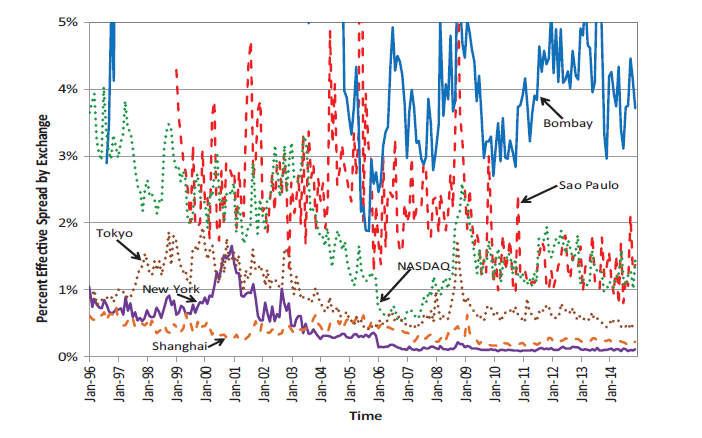
Capital Controls
Various policies are imposed:
- Capital (FX) Controls especially in Emerging Markets
- Special classes of shares for foreigners
- Countries: China, Mexico, Philippines
- shares for foreign investors may sell at a discount or premium to domestic shares
- Authorized foreign investors in their markets
- Countries: India, China
China A-H shares
- A-shares traded in Shenzhen or Shanghai
- H-shares traded in Hongkong
- For the same firm, A shares trades significantly higher than H shares
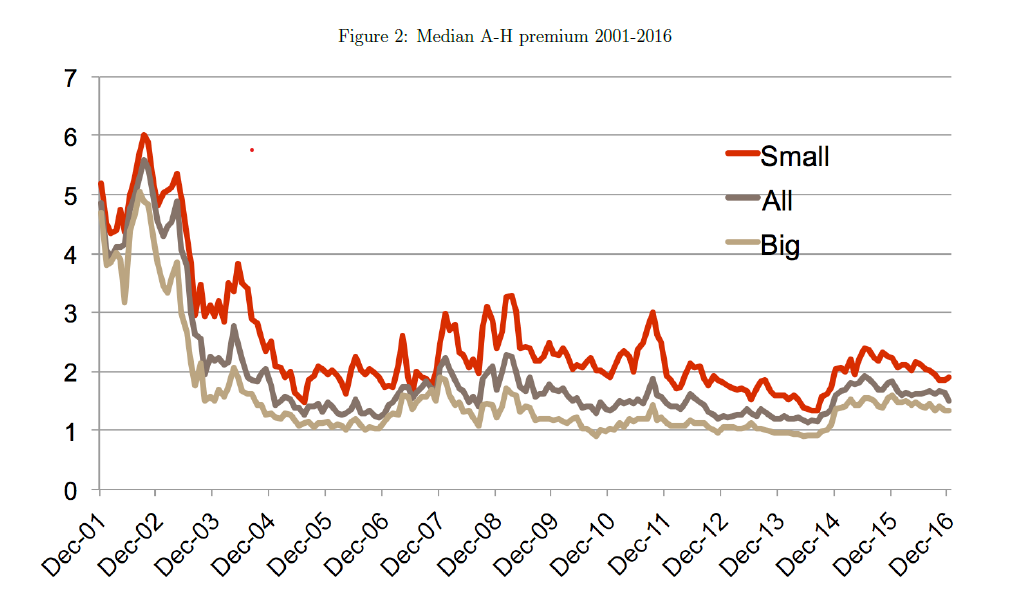
Political Risk
Political Risk: the influence of non-business events on the value of the firm
- Expropriation(充公)
- official government seizure of private property
- Conditions:
- prompt compensation
- at fair market value
- in convertible currencies
- Intl. Telephone and Telegraph in Chile
- Currency or trade controls
- Changes in tax or labour laws
- Changes in ownership policies
- Other political problems
Problems with Expropriation Conditions:
- Promptness is usually delayed by extensive negotiations and appeals.
- Fair market value is in the eyes of the beholder:
- Firms usually argue for a "going concern" value tied to the present value of lost future cash flows.
- Governments frequently argue for depreciated historical book value, which is typically lower.
- Compensation in convertible currencies is usually difficult.
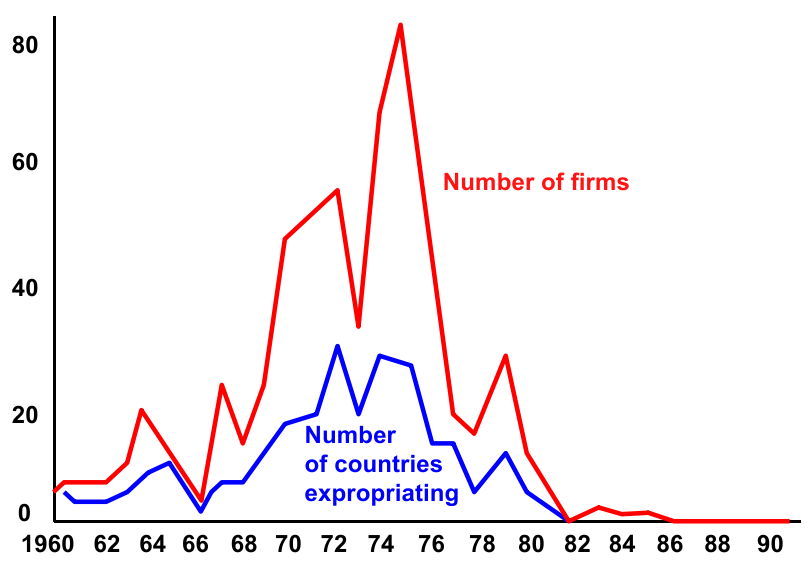
Sovereign Credit Ratings
- S&P ratings
- Moody's
- Fitch
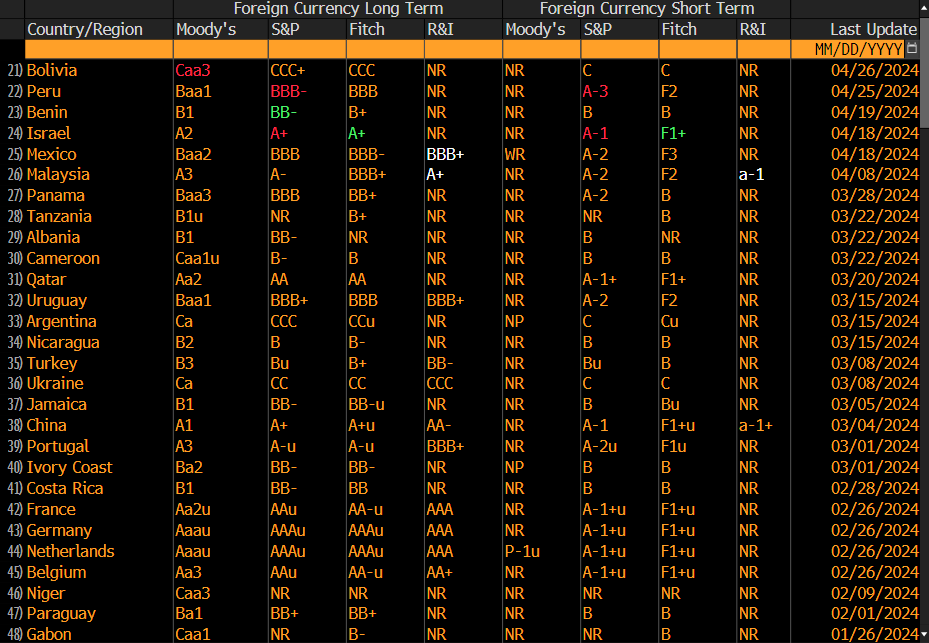
Managing Political Risk
- Take conservative approach:
- Adjust NPV for political risk.
- Political risk may be diversifiable to some extent.
- Don't put all your eggs in one basket.
- Minimize exposure to political risk:
- Joint Venture
- Consortium of international companies
- Use local debt
- Purchase insurance:
- Private insurance
- Overseas Private Investment Corporation (OPIC) in the US and EFIC in Australia
Estimating the Cost of Capital
Cost of Equity:
- : the equity rate of return
- : the risk free rate
- :
The cost of debt:
Global CAPM:
Example: Cost of Debt
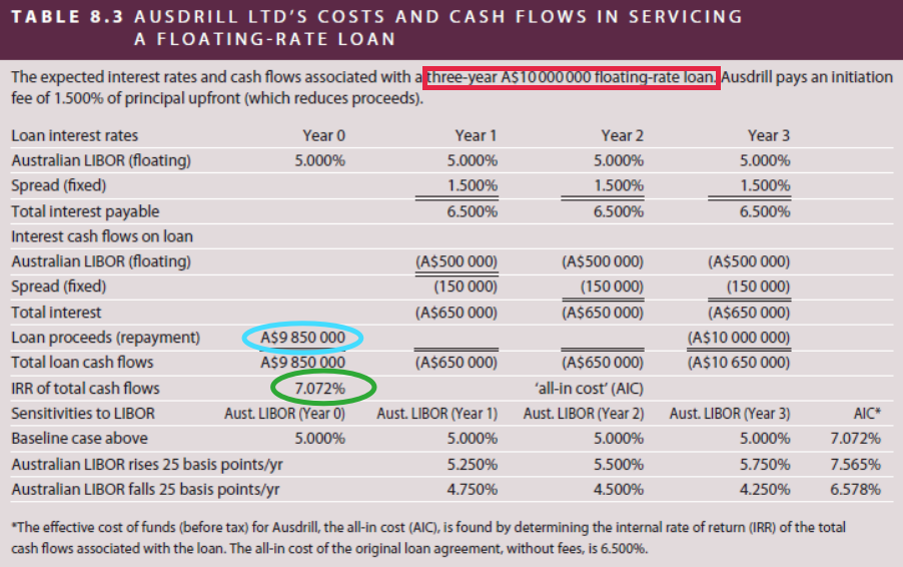
PV(Loan) =
Example: The Case of Nestle

Home CAPM:
World CAPM:
The difference:
=
=
=
= (0.585 - 0.885 × 0.737) × 10.4% = 0.69%
If cost of capital falls 0.69% (say 15% to 14.31%):
- Dividend at = $2, g = 0.09, = 0.15
- P=[ * (1 + g)] / [ - g]
- Value = 2(1.09) / [0.15 – 0.09] = $36.33
- Value = 2(1.09) / [0.1431 – 0.09] = $41.60
- 11% increase in stock price!
Raising Debt Capital
Three major sources
- International bank loans
- Traditionally sourced in Eurocurrency markets
- Eurocurrencies: Domestic currencies of one country on deposit in another
- Any convertible currency can exist in "Euro-" form
- E.g. Eurosterling (£ deposited in banks outside the U.K.)
- The Euronote market
- Euro-Commercial Paper
- Euro-Medium Term Notes
- The international bond market
- Domestic Bonds
- Foreign Bonds
- EuroBonds
Euro-Commercial Paper
- a short-term debt obligation of a corporation or bank
- Short maturity (one, three, six months)
- Usually sold at a discount
- 90%+ in U.S. dollars
Euro-Medium-Term Notes
- Bridge the maturity gap between short-term Euro-Commercial Paper (one, three, six months) and the longer-term and less flexible international bond
- Similar characteristics to bonds.
- Maturities from 9 months to 10 years.
- Coupons paid semi-annually
- Allow continuous issuance over time, instead of all at once like a bond, but coupons dates set
- Usually issue from $2 million to $5 million.
Eurobond: sold exclusively in countries other than the country in whose currency the issue denominated
- a bond issued by a U.S. firm,
- denominated in U.S. dollars,
- but sold to investors in Europe and Japan
- not to investors in the U.S.
American Depository Receipts (ADRs)
- a negotiable U.S. certificate representing ownership of shares in a non-U.S. corporation
- facilitate the purchase, holding and sale of non-U.S. securities by U.S. investors
- provide a financing vehicle (capital raising) for non-U.S. companies
- foreign shares are deposited with a U.S. bank
- bank issues ADRs in the name of the foreign company
- ADRs are quoted and traded in U.S. dollars in the U.S. securities market
- all dividends paid to the investor in U.S. dollars
Sponsored ADRs
- Level I
- Company does not comply with SEC registration and reporting requirements
- shares traded only over-the-counter (but not Nasdaq)
- Level II
- Company registers with SEC and complies with reporting requirements (USGAAP)
- Shares can be listed on official U.S. stock exchange (NYSE, ASE) or Nasdaq
- Level III
- Company listed on U.S. stock exchange or Nasdaq and raises capital in the U.S. through public offering
- Will have to meet all disclosure and accounting requirements
Euroequity
- Newly-issued stock that is simultaneously sold to investors in more than one national market
- Differs from a cross-listing, where company shares are floated in the home market and then listed in a different country
- Complying with multiple regulatory bodies and reporting standards can also be costly
Cross-Listing
- The listing of a company's common shares on a different exchange than its primary and original stock exchange
- Must meet the exchange's listing requirements in order to be cross-listed
- Lower its weighted average cost of capital by:
- Improve liquidity
- Overcome mispricing
- Support new equity issue
- Increase firm's visibility
- Example: Alibaba Group (NYSE and HKEX)
L10 - International Capital Budgeting
Net Present Value
NPV: Present value of future cash flows discounted at an appropriate rate minus the initial net cash outlay for the project
- The discount rate is the expected rate of return on projects of similar risk
- NPV > 0 (Accept)
- NPV < 0 (Reject)
Consider a plant expansion project with the following stream of cash flows:
- Year 0: -4M
- Year 1: 1.2M
- Year 2: 2.7M
- Year 3: 2.7M
- Assuming a 10% cost of capital (r), what's the NPV?
What if constant 3% growth from year 3 onwards?
Terminal value as of year 3 = = = 39.729M
Free Cash Flow
Free Cash Flow to Firm
- Sales
- (-) Costs (operating costs)
- (-) Depreciation and Amortization
- (-) Taxes
- (+) Depreciation and Amortization
- (-) Capital Expenditure
- (-) Change in Working Capital
- (-) Increase in other assets
- (+) Decrease in other liabilities
- (=) Free cash flow of the firm
Free Cash Flow to Equity
- Sales
- (-) Costs (operating costs)
- (-) Depreciation and Amortization
- (-) Taxes
- (+) Depreciation and Amortization
- (-) Capital Expenditure
- (-) Change in Working Capital
- (-) Increase in other assets
- (+) Decrease in other liabilities
- (=) Free cash flow of the firm
- (-) Interest expenses
- (-) Preferred dividends
- (-) Principal repayments
- (+) Proceeds with new debt issues
- (=) Free cash flow to equity
Additional Information
- For other capital providers, e.g., debtholders
- FCF to firm = EBIT*(1-t) + Depreciation - CapEX - ΔNWC
Cash Flows to Claimholders
Equityholders
- Cash Flow:
- Shareholder distribution
- (-) Change in additional paid in capital
- Discount Rate: Cost of equity
Debtholders
- Cash Flow:
- Interest expenses
- (+) Principal repayments
- (-) New debt issues
- Discount Rate: Cost of debt
Preferred stockholders
- Cash Flow: Preferred dividends
- Discount Rate: Cost of preferred stocks
Total Claimholder
- Cash Flow:
- Free cash flow to equity
- (+) Interest expenses
- (+) Principal repayments
- (-) New debt issues
- (+) Preferred dividends
- Discount Rate: Weighted average of capital
Example: Free Cash Flow to Firm Calculation
| 2018 | 2019 | |
|---|---|---|
| Sales | 1,000 | 1,200 |
| Cost of Goods Sold | 700 | 850 |
| Depreciation | 30 | 35 |
| Interest Expense | 40 | 50 |
| Taxes (38%) | 87 | 101 |
| Profit After taxes | 150 | 175 |
| Capital Expenditures | 40 | 40 |
| Accounts Receivable | 50 | 60 |
| Inventories | 60 | 60 |
| Accounts Payable | 20 | 25 |
In 2019: FCF = EBIT*(1+t) + Depreciation - CapEX - ΔNWC
- EBIT = 1,200 - 850 - 35 = 315; tc=38%
- ΔNWC = NWC2019 - NWC2018 = (60+60-25) - (50+50-20) = 15
- FCF2019 = 315 * (1 - 0.38) + 35 - 40 - 15 = 175.3
Notes:
- EBIT (or Operating Income) = Sales + COGS + Depreciation
- NWC = Accounts Receivable + Inventories + Accounts Payable
- EBIT*(1-t) = Net Profits + Int(1-t)*
- 315 * (1-0.38) = [1200-850-35-50] * (1-0.38) + 50 * (1-0.38)=195.3
Incremental Cash Flows
What matters to shareholders are incremental cash flows generated by the project, not the project's total cash flow per period.
- The distinction is crucial
Parent Versus Project Cash Flows
- Tax regulations and exchange controls
- Licensing Agreements, Management fees and royalties
- Transfer price adjustments may shift profits elsewhere in the system
Cannibalization(市场侵蚀)
- when a new product takes sales away from the firm's existing product
- when a firm builds a plant overseas and winds up substituting foreign production for parent company exports
- e.g. iPhone 15 vs. iPhone 14
- If sales of a new product or plant replace existing sales, the new project's earnings must be reduced by the earnings of the lost sales
- However, if those sales would have been lost anyway (to competitors), do not subtract them from the project's NPV
- e.g. iPhone 15 vs. iPhone 14 vs. Samsung Galaxy
Sales Creation
- the opposite of cannibalization
- occurs when an investment creates additional sales for existing products
- e.g., Apple Music / Arcade for iPhone
- the additional sales and associated incremental cash flows should be attributed to the project
Opportunity Cost
- Project costs must include the true economic cost of any resource required for the project, regardless of whether the firm already owns the resource or it has to go out and acquire it
- Suppose IBM decides to build a new office building in Sao Paulo on some land it bought ten years ago
- IBM must include the cost of the land in calculating the value of undertaking the project
- This cost must be based on the current market value of the land, not the price it paid ten years ago
.
Transfer Pricing
- Transfer prices can distort profitability estimates
- Where possible, use market prices
- If no market price exists, use cost savings or additional profits attributable to project
Fees and Royalties
- Often companies will charge projects for legal counsel, power, lighting, heat, rent, R&D, headquarters staff, management costs, etc.
- These charges are costs to the project, but they are a benefit from the standpoint of the parent firm.
- The project should be charged only for the additional expenditures attributable to the project.
- Overhead expenses unaffected by the project should not be included in project cash flows.
- The key question managers must ask is, "What will happen if we don't make this investment?"
Always ask: Will this cash flow occur ONLY if we accept the project?
NPV Example in the International Context
Polaris (Aus), is considering building a plant in Japan its major export market. The plan would cost Yen 3m to build and will produce cash flows of Yen 1m each year for the next 4 years. The investment is risk-free. Other information is:
- Yen interest rate: 2.9%
- Aus interest rate: 8.75%
- Spot rate: 75 Yen/$A
- IRP:
- = Yen 67.148/$A
- = Yen 63.536/$A
- = Yen 60.118/$A
What is the NPV (AUD) for this project in Japan?
Two Approaches to Calculating NPV
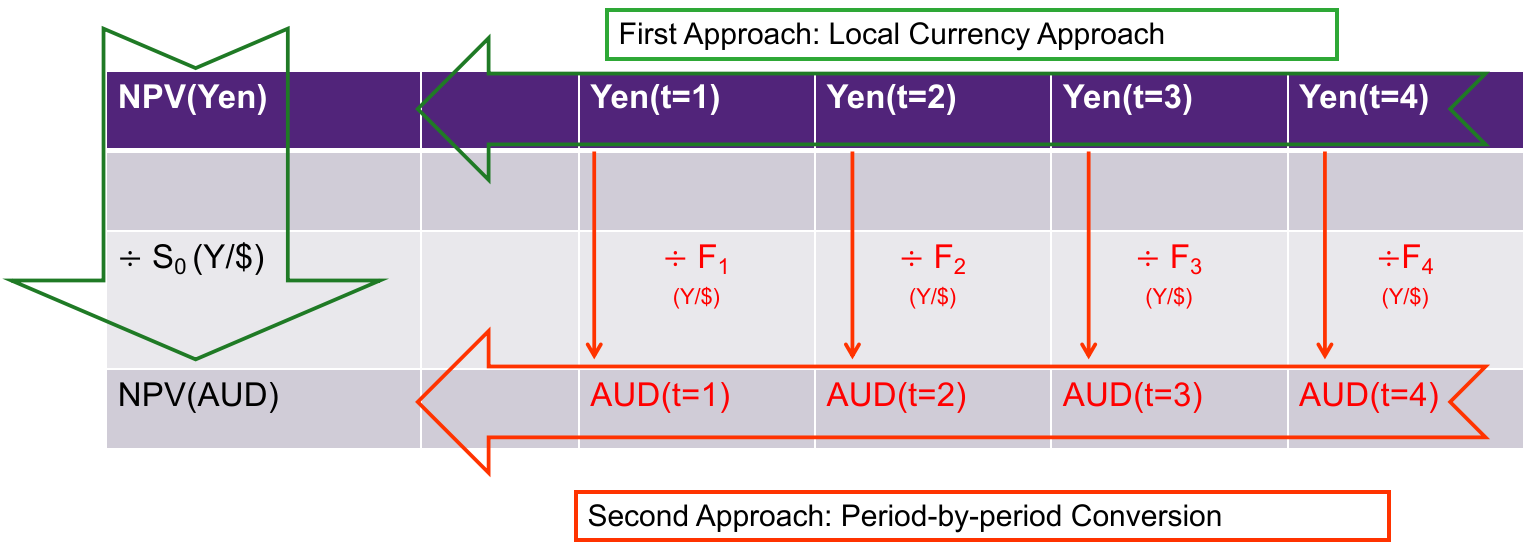
First Approach: Local Currency NPV - Foreign Project
- Perform revenue and cost projections using local currency figures and
- then discount cash flows at the local currency cost of capital.
- Then convert local currency NPV to dollars (home currency) using the current spot rate
- This approach is useful when revenues and costs are in local currency, when investment capital is raised locally and cash flow will be reinvested locally.
- Example: Procter and Gamble raise local debt to invest in a firm in Brazil intended to serve Brazilian markets.
- Don't have to forecast exchange rates.
Second Approach: Period-by-Period Conversion
- Use local currency projections
- Convert each period's cash flow into dollars using the forward rate or exchange rate projections
- Discount the dollar cash flows with a dollar (home country) discount rate with adjustments for country and project risks
- Explicit about exchange rate movements and discount rate adjustments
- Easier to perform sensitivity analysis
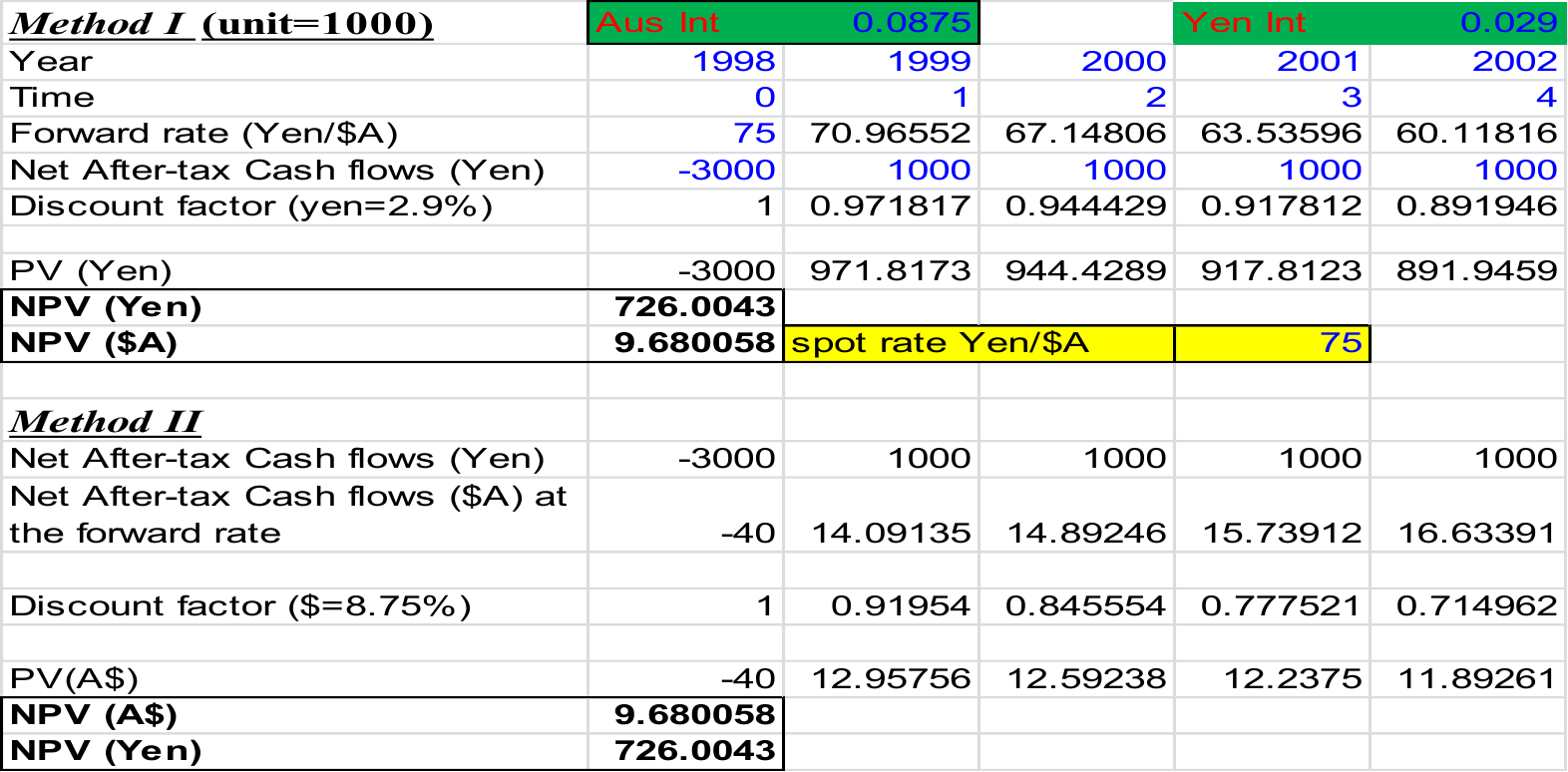
Revisiting the Cost of Equity Capital
Discount Rate: The opportunity cost of investing capital in projects of similar risk and duration.
Discount Rate = Risk free rate + Project Risk Premium
Risk free rate: Risk free treasury bills (Rf)
Project Risk Premium: beta *MRP =
: Return on the market portfolio.
: market risk premium
Beta (β) = project beta = How project returns vary with market return = (Covariance of Project Equity Return with market return) / Variance (Market Return)
Example: Project beta = 0.75, = 6%, Market risk premium = 8%
Discount Rate = 6% + (0.75) * 8% = 12%
Non-Currency Risks
Symmetrical Risks: Risks that might turn out better or worse than the analysts expected value. Country risk and Commercial Risk
Asymmetrical Risk: One-sided risk
Adjusting for country-risk
- Measure of Country Risk (Default Risk)
- The yield on a 10-year US T-bond is 6.25%
- The yield on a Philippine 10 year dollar-denominated bond is 8.8%
- Country Risk = 8.8 – 6.25 = 2.55%
- Discount Rate = + country risk premium +
Adjusting for Commercial Risk (Volatility of Business Environment)
- Adjust the market risk premia
- Discount Rate = (risk free rate + country risk premium) + (relative risk) * (equity premium)
Construct Country Betas: Regress equity returns from individual countries against a world equity portfolio
- Countries with high volatility relative to the U.S can have low betas because of the low correlation of the country's equity performance with the U.S equity market
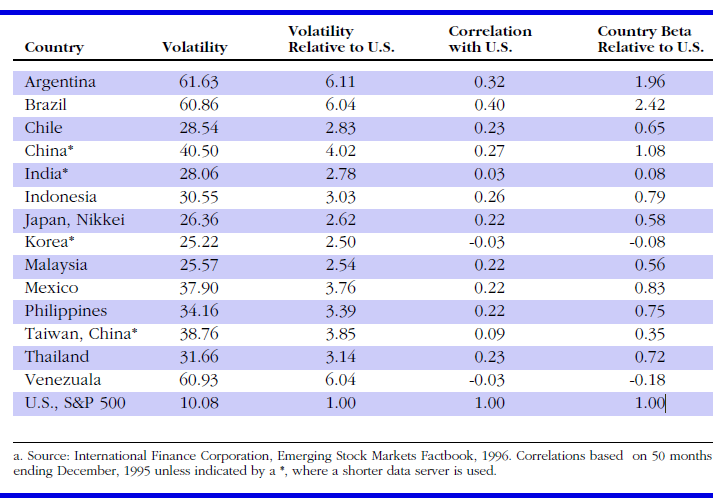
Notes:
- Volatility Relative to US = Country Volatility / US Volatility
- Country with high volatility relative to the U.S can have low betas because of the low correlation of the country's equity performance with the U.S equity market
Estimation of the Cost of Equity Capital
What if project returns are unavailable?
- Use comparables and use the average beta of the portfolio of comparables to proxy for the project's beta
- Issues that need to be addressed include:
- Should the proxies be domestic (Australian) companies or local (foreign=Philippine) companies?
- What is the relevant market portfolio?
- Should the market risk premium be based on the domestic (Australian) market or the local (foreign) market?
Real options
A real option gives a firm's management the right, but not the obligation to undertake certain business opportunities or investments
Firms are confronted with many possible real options over the life of a project
- A timing option is an option on when to make the investment.
- A growth option is an option to increase the scale of the investment.
- A suspension option is an option to temporarily cease production.
- An abandonment option is an option to quit the investment early.
These uncertainties make real options analysis valuable to use in evaluating international projects
- An extension to NPV analysis
Revision Lecture
L5 - FX Derivatives
- Forward / Futures / Options
- Pro and cons to use the tools to hedge
- Swap
- Interest rate swap
- Cross-currency swap
L6 - Transaction and Translation Exposure
- Transaction (Contractual) Exposure
- How is it measured?
- Methods of Hedging Transaction Exposure
- Financial instruments (Futures/Forward, MMH, Option)
- Operational Hedges
- Translation (Accounting) Exposure
L7 - Economic Exposure
- What is it?
- How does it impact the firm?
- How do we measure it?
- How do we hedge and should we hedge at all?
L8 - International Portfolio Management
- Why should we diversify internationally?
- Why don't we diversify as much as we should?
- The home bias puzzle
- Is currency risk important?
- Measuring foreign investment performance (Return vs Risk)
L9 - Cost of Capital and Political Risk
- Capital Market Integration/Segmentation and its impact on the cost of capital
- What is political risk and how do we measure it?
- How do we manage political risk?
- Avenues to raise capital
- International Bond Market
- International Equity Markets
L10 - International Capital Budgeting
- How do we decide whether a firm should proceed with foreign project(s)?
- What are we maximizing?
- How does international capital budgeting differ from the domestic setting?
Epilogue
这个课,感觉就是把本科的一些东西快速复习了一轮,部分内容会稍微比本科深入一些。如果本科基础没打好的话,估计就会比较吃力了。